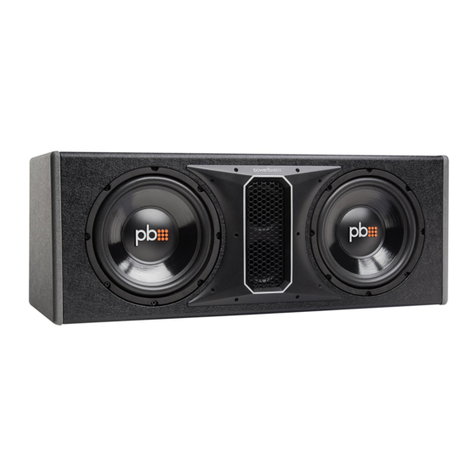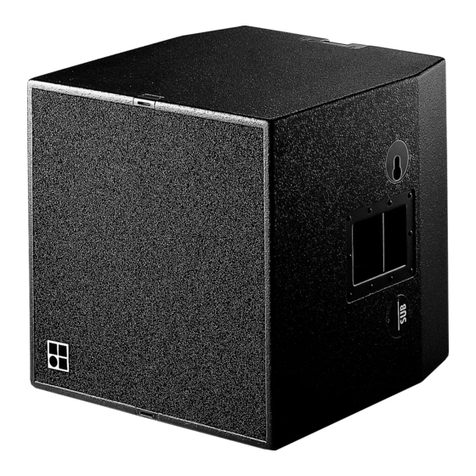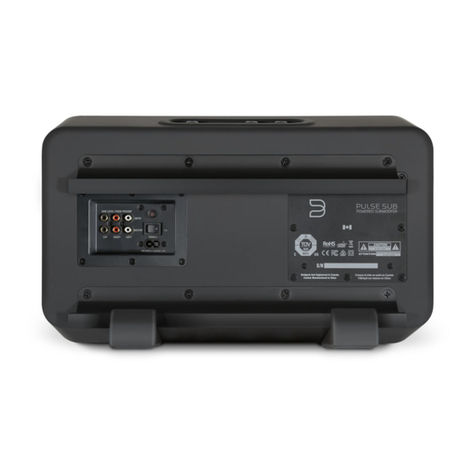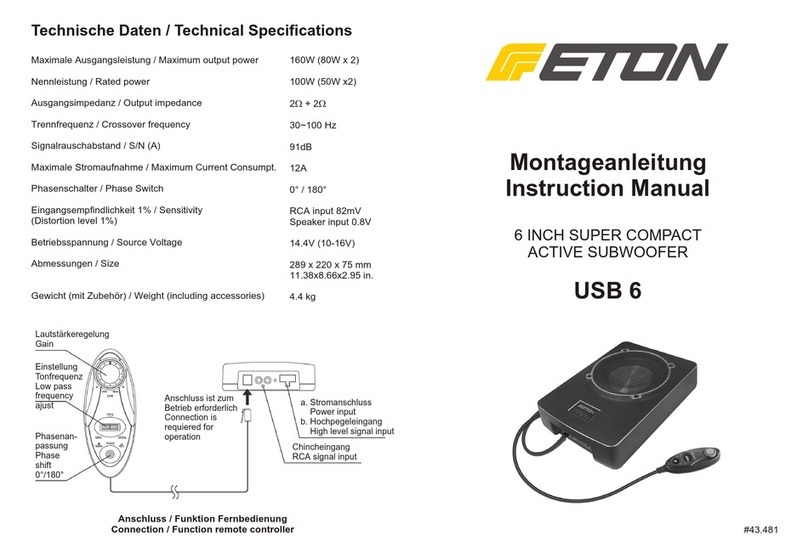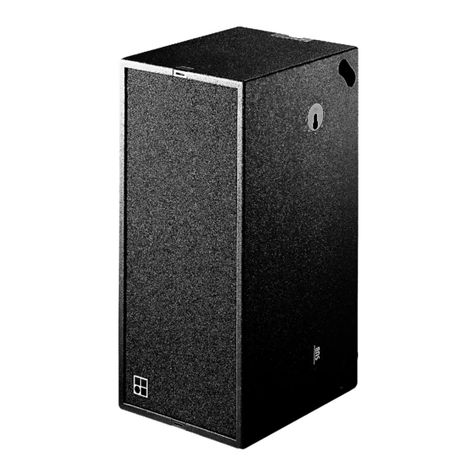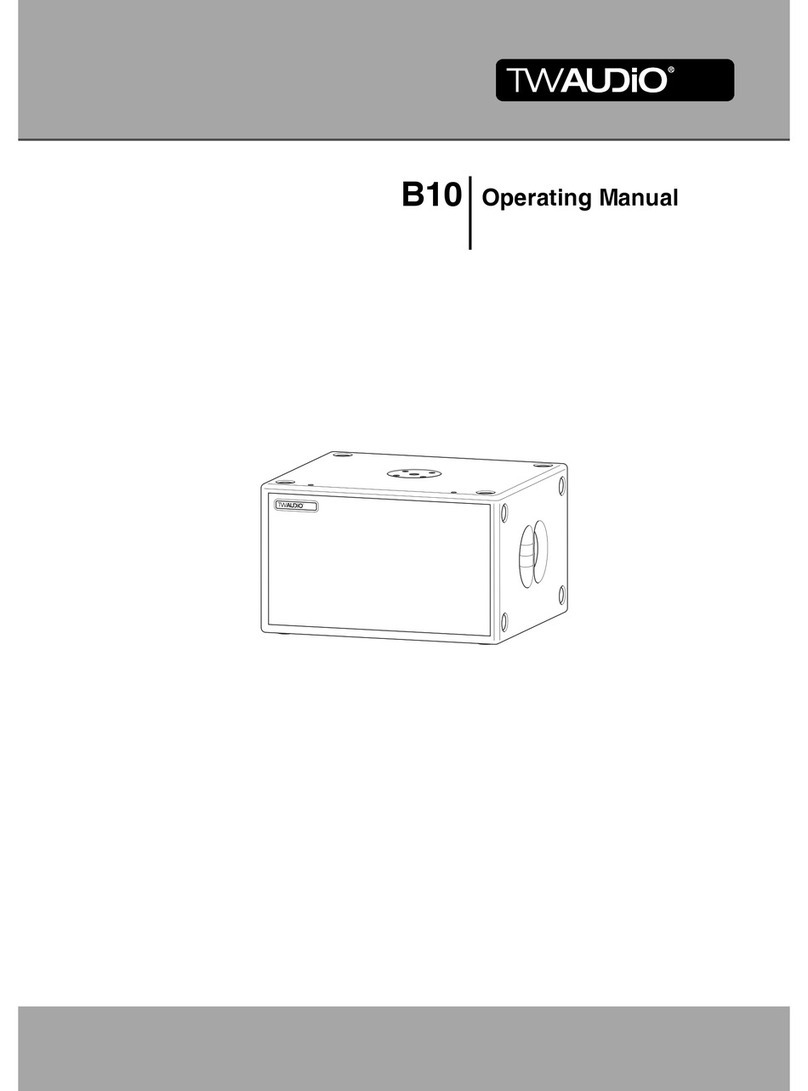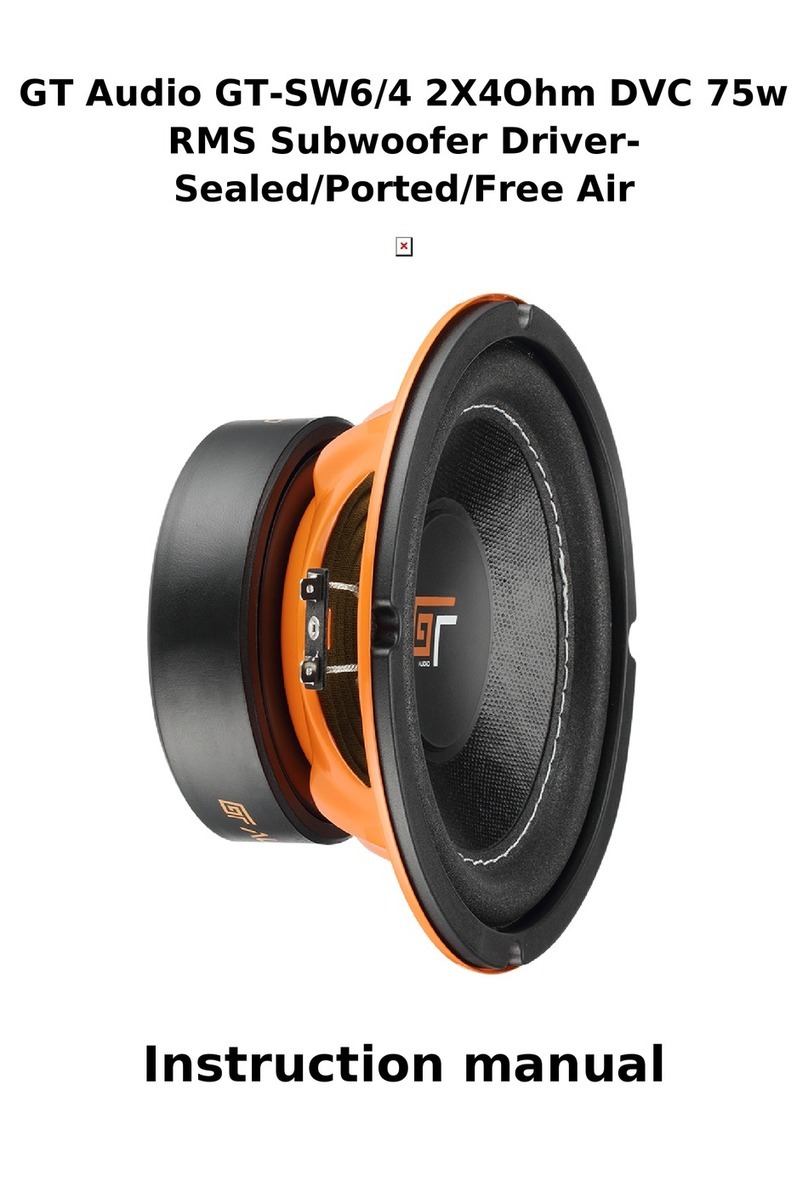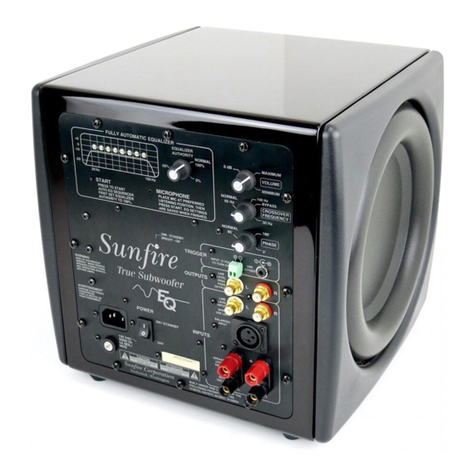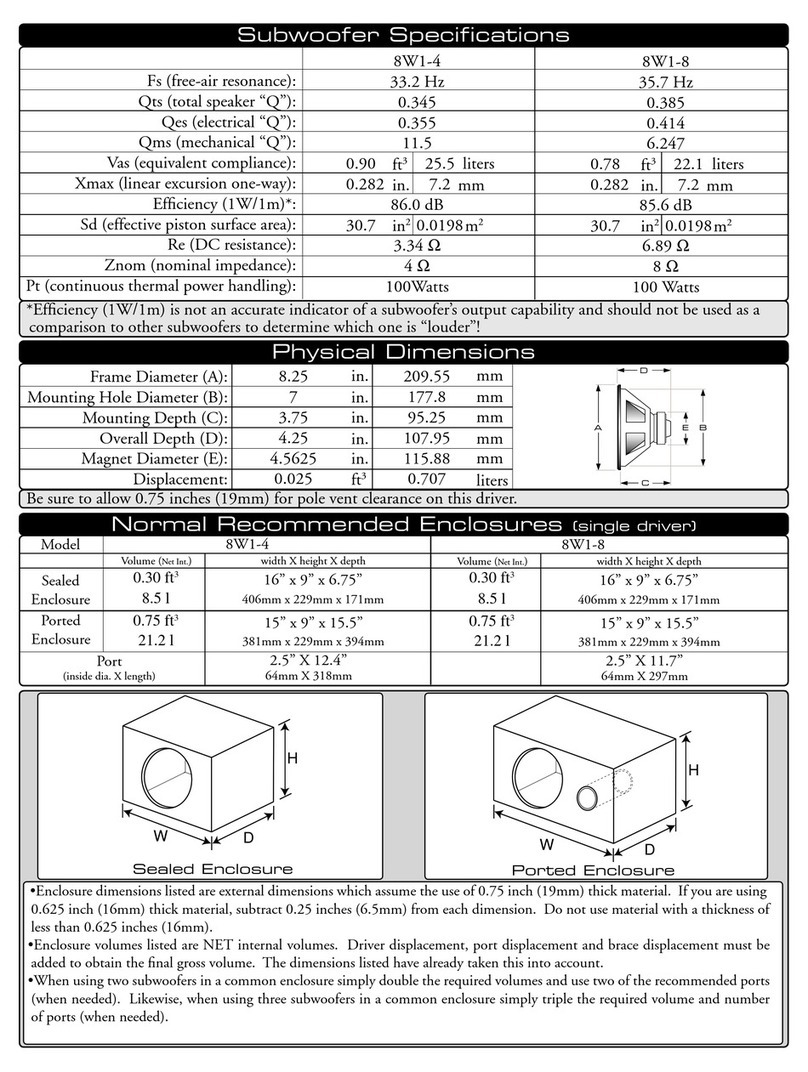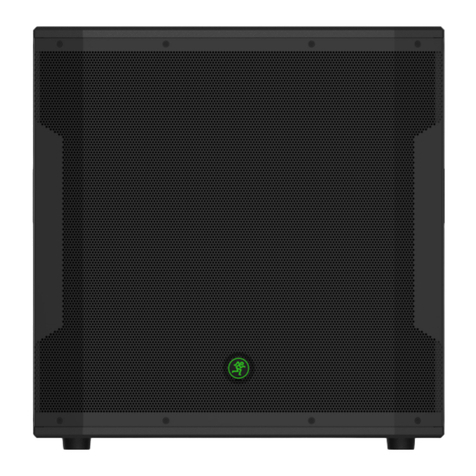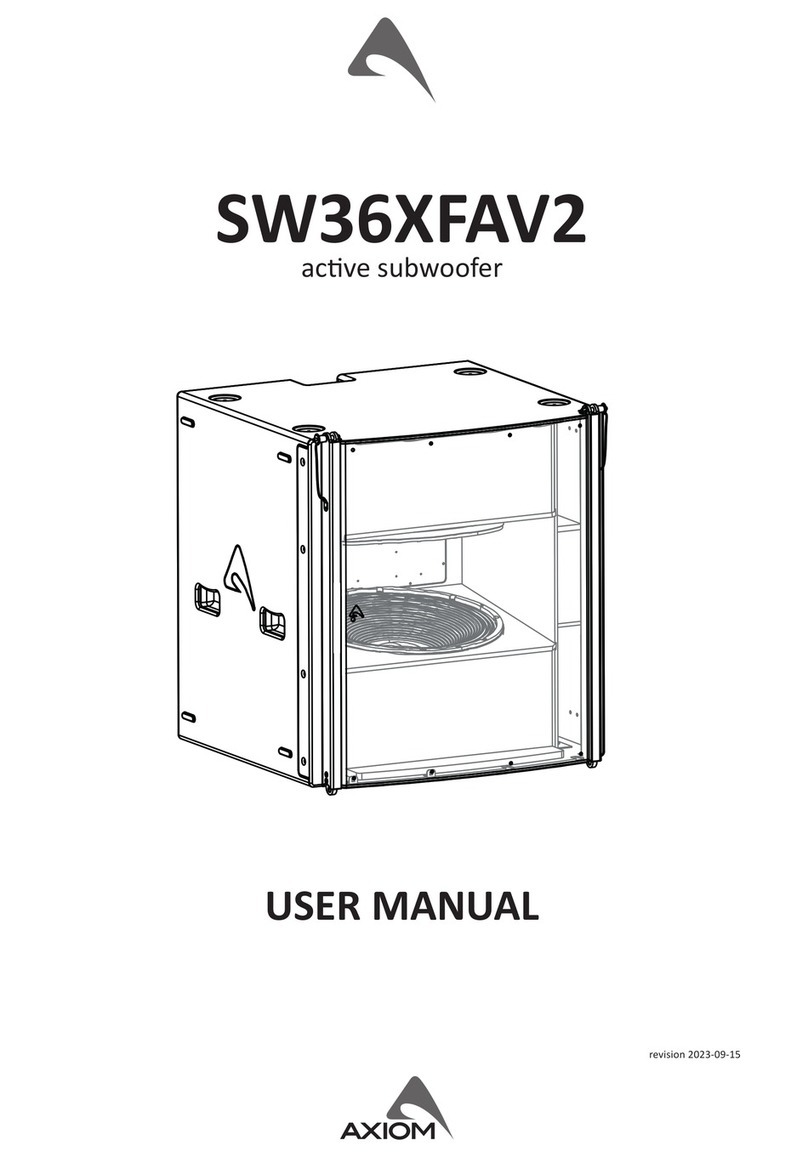HK Audio SONAR 115 Sub D User manual

Manual 1.1
SONAR
115 Sub D
• English • Deutsch • Français • Italiano • Español

Important Safety Instructions!
Read before connecting!
This product has been built by the manufacturer in accordance with
IEC 62368-1 and left the factory in safe working order. To maintain
this condition and ensure non-risk operation, the user must follow the
advice and warning comments found in the operating instructions. If
this product shall be used in vehicles, ships or aircraft or at altitudes
exceeding 2000 m above sea level, take care of the relevant safety
regulations which may exceed the IEC 62368-1 requirements.
WARNING: To prevent the risk of fire and shock hazard, do not
expose this appliance to moisture or rain. Do not open case – no user
serviceable parts inside. Refer service to qualified service personnel.
This symbol, wherever it appears, alerts you to the presence
of uninsulated dangerous voltage inside the enclosure – voltage that
may be sufficient to constitute a risk of shock.
This symbol, wherever it appears, alerts you to the presence
of externally accessible hazardous voltage. External wiring connected
to any terminal marked with this symbol must be a "ready made
cable" complying with the manufacturers recommendations, or must
be a wiring installed by instructed persons only.
This symbol, wherever it appears, alerts you to important
operating and maintenance instructions in the accompanying
literature. Read the manual.
This symbol, wherever it appears, tells you: Take care! Hot
surface! To prevent burns you must not touch.
All electrical and electronic products including batteries
should be disposed of separately from the municipal waste stream via
designated collection facilities appointed by the government or the
local authorities.
Read these instructions. Keep these instructions. Follow all
warnings and instructions marked on the product and in this manual.
• Do not use this product near water. Do not place the product near
water, baths, wash basins, kitchen sinks, wet areas, swimming pools
or damp rooms.
• Do not place objects containing liquid on the product – vases,
glasses, bottles etc.
• Clean only with dry cloth.
• Do not remove any covers or sections of the housing.
• The set operating voltage of the product must match the local mains
supply voltage. If you are not sure of the type of power available
consult your dealer or local power company.
• Before connecting the device, please ensure that the mains supply
you are using is equipped with adequate protection against short
circuiting and grounding faults when the device is plugged in.
• To reduce the risk of electrical shock, the grounding of this product
must be maintained. Use only the power supply cord provided with
this product, and maintain the function of the center (grounding)
pin of the mains connection at any time. Make sure the mains outlet
used provides a proper protective ground connection.
• Do not defeat the safety purpose of the polarized or grounding-type
plug. A polarized plug has two blades with one wider than the other.
A grounding type plug has two blades and a third grounding prong.
The wide blade or the third prong are provided for your safety. If the
provided plug does not fit into your outlet, consult an electrician for
replacement of the obsolete outlet.
• Protect the power cord from being walked on or pinched particularly
at plugs, convenience receptacles, and the point where they exit
from the device! Power supply cords should always be handled
carefully. Periodically check cords for cuts or sign of stress, especially
at the plug and the point where the cord exits the device.
• Never use a damaged power cord.
• Unplug this product during lightning storms or when unused for long
periods of time.
• This product can be fully disconnected from mains only by pulling
the mains plug at the unit or the wall socket. The product must be
placed in such a way at any time, that disconnecting from mains is
easily possible.
• Fuses are to be replaced exclusively by qualified personnel, and then
only with fuses of the proper type and rating.
• Refer all servicing to qualified service personnel. Servicing is
required when the unit has been damaged in any way, such as:
- When the power cord or plug is damaged or frayed.
- If liquid has been spilled or objects have fallen into the product.
- If the product has been exposed to rain or moisture.
- If the product does not operate normally when the operating
instructions are followed.
- If the product has been dropped or the cabinet has been damaged.
• Do not connect external speakers to this product with an impedance
lower than the rated impedance given on the product or in this
manual. Use only cables with sufficient cross section according to
the local safety regulations.
• Keep away from direct sunlight.
• Do not install near heat sources such as radiators, heat registers,
stoves or other devices that produce heat.
• This apparatus is for moderate climates areas use, not suitable for
use in tropical climates countries.
• Do not block any ventilation openings. Install in accordance with
manufacturer's instructions. This product must not be placed in
a built-in installation such as a rack unless proper ventilation is
provided.
• Always allow a cold device to warm up to ambient temperature,
when being moved into a room. Condensation can form inside it and
damage the product, when being used without warming up.
• Do not place naked flame sources, such as lighted candles on the
product.
• The device must be positioned at least 20 cm/8" away from walls.
• Use only with the cart, stand, tripod, bracket or table specified by
the manufacturer or sold with the product. When a cart is used, use
caution when moving the cart/product combination to avoid injury
from tip-over.
• Use only accessories recommended by the manufacturer, this applies
for all kind of accessories, for example protective covers, transport
bags, stands, wall or ceiling mounting equipment. In case of
attaching any kind of accessories to the product, always follow the
instructions for use, provided by the manufacturer. Never use fixing
points on the product other than specified by the manufacturer.
• This appliance is NOT suitable to be used by any person or persons
(including children) with limited physical, sensorical or mental
ability, or by persons with insufficient experience and/or knowledge
to operate such an appliance. Children under 4 years of age must be
kept away from this appliance at all times.
• Never push objects of any kind into this product through cabinet
slots as they may touch dangerous voltage points or short out parts
that could result in risk of fire or electric shock.
• This product is capable of delivering sound pressure levels in excess
of 90 dB, which may cause permanent hearing damage! Exposure
to extremely high noise levels may cause a permanent hearing loss.
Wear hearing protection if continously exposed to such high levels.
• The manufacturer only guarantees the safety, reliability and
efficiency of this product if:
- Assembly, extension, re-adjustment, modifications or repairs are
carried out by the manufacturer or by persons authorized to do so.
- The electrical installation of the relevant area complies with the
requirements of IEC (ANSI) specifications.
- The unit is used in accordance with the operating instructions.
• This product is optimized for use with music and speech signals.
Using this product with sine wave, square wave or other kind of
measuring signals at higher level may lead to severe damage of the
product.
General Notes on Safety for Loudspeaker
Systems
Mounting systems may only be used for those loudspeaker
systems authorized by the manufacturer and only with the mounting
accessories specified by the manufacturer in the installation
instructions. Read and heed the manufacturer's installation
instructions. The indicated load-bearing capacity cannot be guaranteed
and the manufacturer will not be liable for damages in the event of
improper installation or the use of unauthorized mounting accessories.
The system's load-bearing capacity cannot be guaranteed and
the manufacturer will not be liable for damages in the event that
loudspeakers, mounting accessories, and connecting and attaching
components are modified in any way.
Components affecting safety may only be repaired by the manufacturer
or authorized agents, otherwise the operating permit will be voided.
Installation may be performed qualified personnel only, and
then only at pick-points with sufficient load-carrying capacity and
in compliance with local building regulations. Use only the mounting
hardware specified by the manufacturer in the installation instructions
(screws, anchors, etc.). Take all the precautions necessary to ensure
bolted connections and other threaded locking devices will not loosen.
Fixed and portable installations (in this case, speakers and
mounting accessories) must be secured by two independent safeties to
prevent them from falling. Safeties must be able to catch accessories
or parts that are loose or may become loose. Ensure compliance with
the given national regulations when using connecting, attaching,
and rigging devices. Factor potential dynamic forces (jerk) into the
equation when determining the proper size and load-bearing capacity
of safeties.
Be sure to observe speaker stands' maximum load-bearing
capacity. Note that for reasons of design and construction, most
speaker stands are approved to bear centric loads only; that is, the
speakers' mass has to be precisely centered and balanced. Ensure
speaker stands are set up stably and securely. Take appropriate added
measures to secure speaker stands, for example when:
- the floor or ground surface does not provide a stable, secure base.
- they are extended to heights that impede stability.
- high wind pressure may be expected.
- there is the risk that they may be knocked over by people.
Special measures may become necessary as precautions against
unsafe audience behavior. Do not set up speaker stands in evacuation
routes and emergency exits. Ensure corridors are wide enough and put
proper barriers and markings in place when setting speaker stands up
in passageways. Mounting and dismounting are especially hazardous
tasks. Use aids suitable for this purpose. Observe the given national
regulations when doing so.
Wear proper protection (in particular, a helmet,
gloves, and safety shoes) and use only suitable means of ascent
(ladders, scaffolds, etc.) during installation. Compliance with this
requirement is the sole responsibility of the company performing the
installation.
WARNING! After installation, inspect the system comprised
of the mounting fixtures and loudspeakers to ensure it is properly
secured.
The operator of loudspeaker systems (fixed or portable) must
regularly inspect or task a third party to regularly inspect all system
components in accordance with the given country's regulations and
have possible defects repaired immediately.
We also strongly recommend maintaining a logbook or the like to
document all inspections.
Also be sure to provide sufficient safety margins for the rigging points
used for flown systems. Observe the given national regulations when
doing so.
Professional loudspeaker systems can produce harmful
volume levels. Even prolonged exposure to seemingly harmless levels
(starting at about 95 dBA SPL) can cause permanent hearing damage!
Therefore we recommend that everyone who is exposed to high volume
levels produced by loudspeaker systems wears professional hearing
protection (earplugs or earmuffs).
Manufacturer: Stamer Musikanlagen GmbH, Magdeburger Str. 8, 66606
St. Wendel, Germany
Version 2.8 08/2019

SONAR 115 Sub D 1.1
3
Welcome to the HK Audio family!
Thank you for choosing a brand-name product made by our company. Rest
assured, we engineered and built it with the greatest care so it will serve
you well for many tomorrows to come.
Even if your experience with sound systems runs deep, some things
about this product are sure to be new to you. This is why we ask that you do
not set this manual aside without reading it first. Be sure to keep it in a
safe place for later reference.
Here's wishing you the best sound at every occasion!
Your HK Audio team
Powerful electromagnetic interference and electrostatic
discharges may impair this unit's operation. In the event of such
interference, switch the device o and back on again. If this fails to
restore normal operations, please move the unit away from the source of
interference and try again.
Warranty
Use the convenient online registration option at www.hkaudio.com.
http://warranty.hkaudio.com
The registration is only valid if the device is registered within 30 days of
the date of purchase.
HK Audio
Technischer Service
Postfach 1509
66595 St. Wendel, Germany
Fax: +49 6851 905 100
SONAR 115 Sub D
• English • Deutsch • Français • Italiano • Español

SONAR 115 Sub D 1.1
4
Caution:
To reduce
the risk of
electric
shock,
grounding
of the center
pin of this
plug must be
maintained.
SONAR
115 Sub D
Volume
Push to edit
Input
L
Thru
L
Input
R
Thru
R
On
O
PowerMains
Leave enough space for proper ventilation!
24bit Digital Signal Processor
Serial No.
HK Audio is a brand of Stamer Musikanlagen GmbH
.BHEFCVSHFS4USŦ4U8FOEFMŦ(FSNBOZ
7_Ţ)[
"!PVUQVUQPXFS
This device complies with part 15 of the FCC Rules. Operation is
TVCKFDUUPUIFGPMMPXJOHUXPDPOEJUJPOT5IJTEFWJDFNBZOPU
DBVTFIBSNGVMJOUFSGFSFODFBOEUIJTEFWJDFNVTUBDDFQUBOZ
JOUFSGFSFODFSFDFJWFEJODMVEJOHJOUFSGFSFODFUIBUNBZDBVTF
undesired operation. $POGPSNTUP6-45%
Certified to CSA STD. C22.2
/P
Caution: Risk of electric shock! Do not open!
Refer servicing to qualified service personnel.
1
2
3 4
3 4
5 6
1 Connectors and Controls
●
1Display
The display indicates the volume level and aords you access to further
DSP functions.
• See section 2, DSP Menu, for more on this.
●
2Volume (Push to edit)
The Volume knob on the right of the display serves primarily to adjust the
level. The display indicates the current value; the control range sweeps from
mute to +10 dB.
This is a push-to-edit control that you can turn and press to access and
adjust various settings. The display highlights the currently selected
parameter. Turn the Volume knob to navigate the menu. Press it to select
the current menu option or confirm your entry.
●
3Input (L/R)
These balanced XLR / 1/4" (6.35 mm) combo jacks accept an XLR connector
or a balanced or unbalanced 1/4" (6.35 mm) jack plug.
Heads up: A balanced signal is always preferable because it is less
susceptible to HF and other interference.
●
4Thru (L/R)
These balanced XLR outputs route the input signals back out without
further processing.
●
5Mains
Please use the factory-included power cable to connect this IEC mains
socket to a wall outlet.
Be sure your speaker is turned o before you plug the mains supply cord
into an electrical outlet.
Caution: Make sure the local mains voltage matches the voltage specified
on the product. Connecting it to the wrong mains voltage may destroy its
electronic components.
Caution: It is essential to ensure that the fan is not covered or blocked.
●
6Power
This on/o button powers the system up and down. When you switch
SONAR 115 Sub D on, it loads the most recently used DSP settings and will
be ready to operate within seconds when the volume setting appear in the
display.
●
7Pole Mount socket
The M20 pole mount accepts speaker extension poles with an M20 thread.
7

SONAR 115 Sub D 1.1
5
2 DSP Menu
Press the push-to-edit Volume knob to access and edit DSP parameters.
Turn the Volume knob to navigate the menu. The display shows the
currently selected parameter. Press the Volume knob to confirm your entry.
Volume
Push to edit
Note: SONAR exits the selected menu option, automatically returning to
the main volume screen if you do not make or confirm an entry within eight
seconds. It does this to prevent unintentional editing or operating errors.
Heads up: The system's memory stores all current DSP settings when you
power it down and reloads those settings when you power the system back
up again.
2.1 Examples of the menu structure
• Main screen
1 3
2 4
5
1Bass Boost status indicator (Normal or Bass Boost)
2Mode status indicator (operating modes: Normal, Cardioid Front or
Cardioid Rear)
3X-Over status indicator (crossover frequency: 60 Hz – 150 Hz variable or
SONAR)
4Delay status indicator (O – 10 m / 33 ft)
5Volume display: Turn the volume knob to change the output level
• Menu list
Volume
Push to edit
2
3
1
1Turn the Volume knob to scroll through the menu items
2Shows the currently selected item
3Push the Volume knob to confirm the selected item and access menu
options
• Selecting a menu option
2
3
1
1Currently selected item
2Visual rendering of the currently selected item
3Push the Volume knob to save and exit this menu option
2.2 Menu Items
Exit
This menu item can be used to exit the DSP menu and return to Volume.
This happens automatically if there is no action via the volume control
within 8 seconds.
Bass Boost
Activate this option for a low-end boost at around 40 Hz.
Options: O, On
Note: Access to this parameter is blocked in the "Cardioid Front" and
"Cardioid Rear" modes.
Mode
You have a choice of standard operating mode and two optimized pre-
sets for cardioid setups.
Options: Normal, Cardioid Front, Cardioid Rear
You'll get the following message when you activate a Cardioid mode: "Some
menu items are locked in Cardioid modes. For proper operation, set volume
of all subwoofers to same level." Select OK or Cancel to proceed.
Note: Bass Boost, Polarity, X-Over and Delay parameters are preconfigured
in Cardioid Front and Cardioid Rear modes to deliver the best response and
cannot be adjusted. In order to operate the locked parameters, you must
switch to the "Normal" operating mode.
Polarity
Polarity Reverse is a handy feature to have when you want to match the
subwoofer to other speakers. Select Reverse to invert the polarity 180°.
Options: Normal, Reverse
Note: Access to this parameter is blocked in the "Cardioid Front" and
"Cardioid Rear" modes..
X-Over
This option adjusts the crossover frequency – that is, the frequency at
which the signal is cut o and sent to another speaker. Set the proper
frequency for the connected speaker or select the SONAR preset to
match the sub's response to suit SONAR Xi fullrange speakers.
Options: SONAR, 60 Hz – 150 Hz
Note: Access to this parameter is blocked in the "Cardioid Front" and
"Cardioid Rear" modes.
• English • Deutsch • Français • Italiano • Español

SONAR 115 Sub D 1.1
6
Delay
This option delays the subwoofer's signal to align it with that of other
speakers.
Options: 0 to 10m/33ft
Note: Access to this parameter is blocked in the "Cardioid Front" and
"Cardioid Rear" modes.
Front LED
You can choose to have the front LED remain on, o or show limiter
activity.
Options: O, On, Limit
If the LED flashes briefly red from time to time, this tells you that the
limiter is responding to signal peaks.
Heads up! If the Front LED stays red during operation, the system is
being overloaded. Turn down the signal level! If you are not feeding a
signal in and the Front LED stays red, a malfunction has occurred.
Display Dim
Use this option to dim the display if you do not need it to be illuminated
all the time.
Options: O, On
The display stays lit when this option is set to O. When it is set to On,
the display dims 8 seconds after the Volume knob was last engaged. The
display lights up again the next time the Volume knob is engaged, and then
dims again after ten seconds with no activity.
Note: A dark display could lead you to believe the subwoofer has been
switched o, which is why this is a temporary setting. It's lost when the
unit powers down. If you want to dim the display, you'll have to reset this
option every time you power the unit up.
Reset
This option restores all parameters to their factory defaults when you
answer the following prompt with yes: "Reset to default settings. Are
you sure?"
Options: No, Yes
Good to know: this is e.g. useful when the subwoofer is loaned out
frequently. This way it can be quickly restored to its factory condition before
handing it over to a new customer.
3 Example Applications
Note: The following examples are in combination with SONAR Xi series
active mid/high units. Simply set these to "Ext. Sub: On" mode, and they
perfectly match the SONAR 115 Sub D.
• 2.1 Stereo System (single subwoofer)
Front view
Signal flow:
External mixer Out L/R SONAR Sub In L/R
SONAR Sub Thru L/R 2x SONAR Xi Line In
Settings:
MODE Normal
X-OVER SONAR (or set the frequency to match other speakers)
Further settings as required
For a balanced image, center the subwoofer between the two mid/high
units.
• Half-stack System (one subwoofer per side)
Front view
Signal flow:
External mixer out L/R 2x SONAR Sub In (L or R each)
2x SONAR Sub Thru (L or R each) 2x SONAR Xi Line In
Settings:
MODE Normal
X-OVER SONAR (or set the frequency to match other speakers)
Further settings as required
• Full-stack System (two subwoofers per side)
#1
#2 Side view
Signal flow:
External mixer Out L/R 2x SONAR Sub #2 In (L or R each)
2x SONAR Sub #2 Thru (L or R each) 2x SONAR Sub #1 In (L or R each)
2x SONAR Sub #1 Thru (L or R each) 2x SONAR Xi Line In

SONAR 115 Sub D 1.1
7
Settings:
MODE Normal
X-OVER SONAR (or set the frequency to match other speakers)
Further settings as required
• Full-stack System with Cardioid Subwoofers
(two subwoofers per side)
SONAR 115 Sub D comes with two presets, Cardioid Front and Cardioid Rear,
that provide a fast, easy way of configuring eective cardioid setups.
Note: For a cardioid setups to work properly, the two subwoofers must be
stacked on top of each other. The top subwoofer (sub #1) has to face the
audience (Front); the bottom subwoofer (sub #2) has to face the stage
(Rear). A side-by-side array will not achieve the desired eect! Also, be
sure to always maintain a distance of at least one meter from walls.
#1
#2 Side view
Signal flow:
External mixer Out L/R 2x SONAR Sub #2 In (L or R each)
2x SONAR Sub #2 Thru (L or R each) 2x SONAR Sub #1 In (L or R each)
2x SONAR Sub #1 Thru (L or R each) 2x SONAR Xi Line In
Settings:
MODE Sub #1: "Cardioid Front"
Sub #2: "Cardioid Rear"
Set both subwoofers to the same volume level
Note: In "Cardioid Front" and "Cardioid Rear" operating modes, the menu
items Bass Boost, Polarity, X-Over and Delay are locked and cannot be
changed by the user (see "2.2 Menu items / Mode").
Good to know: While speakers are able to throw midrange and high
frequencies in directional patterns, low frequencies tend to radiate in all
directions. Excessive bass levels can often be a problem on and behind the
stage. These days, demands for limiting low-range frequencies' throw range
to clean up the on-stage sound with cardioid subwoofer configurations.
What is a cardioid setup? Put simply, it's a bass rig where one or more
subwoofer(s) points towards the audience and the other subwoofer(s)
face(s) the stage. With some phase rotation and delays, this setup
delivers practically undiminished bass response to the front while heavily
attenuating the amount of bass thrown to the rear. This cleans up the on-
stage sound.
Good to know: Set the rearward-facing subwoofer's Display Dim option to
On if the light is distracting. This temporary setting is lost when the unit
powers down. You'll have to set this option again every time you power the
unit up.
4 Optional HK Audio Accessories
The variety of accessories may dier from time and region. Please visit the
SONAR product page at www.hkaudio.com to learn more.
5 Technical Specifications
Modell SONAR 115 Sub D
Max. SPL @ 10% THD 125 dB half space
Max. SPL peak 128 dB half space
Frequency response +/- 3 dB 40 Hz – X-over
Frequency response -10 dB 36 Hz – X-over
Power amp output (peak power) 1500 W
Amp type Class D
Active protective circuits Subsonic Filter, Thermo Protection, Overload Protection; Peak,
RMS Limiter
Bass woofer 1x 15", 3" voice coil
Active x-over frequency 60 – 150 Hz, variable
Display 2.2" LCD
Audio ports in 2x XLR Combo In bal.
Audio ports out 2x XLR Thru bal.
Setup modes Cardioid Front, Cardioid Rear, SONAR
DSP functions Bass Boost, Polarity, X-Over, Delay, Front LED, Display Dim, Reset
Delay up to 10 m
Power consumption 0.8 A / 220-240 V AC • 1.6 A / 100-120 V AC
Nominal according to EN 62368-1
Pole mount 1x M20
Grips 2x MultiGrip
Housing Wood
Finish Black acrylic enamel
Front grille Metal grille backed with black acoustic foam
Dimensions (WxHxD) 43 x 61.2 x 61.6 cm • 16-15/16 x 24-61/64 x 24-17/64"
Weight 28.4 kg / 62.6 lbs
FCC STATEMENT
Changes or modifications not expressly approved by the party responsible for compliance could void
the user's authority to operate the equipment.
NOTE: This equipment has been tested and found to comply with the limits for a Class B digital device,
pursuant to Part 15 of the FCC Rules. These limits are designed to provide reasonable protection
against harmful interference in a residential installation.
This equipment generates uses and can radiate radio frequency energy and, if not installed and used in
accordance with the instructions, may cause harmful interference to radio communications. However,
there is no guarantee that interference will not occur in a particular installation. If this equipment
does cause harmful interference to radio or television reception, which can be determined by turning
the equipment off and on, the user is encouraged to try to correct the interference by one or more of
the following measures:
• Reorient or relocate the receiving antenna.
• Increase the separation between the equipment and receiver.
• Connect the equipment into an outlet on a circuit different from that to which the receiver is
connected.
• Consult the dealer or an experienced radio/TV technician for help.
FCC Radiation Exposure Statement
This equipment complies with FCC radiation exposure limits set forth for an uncontrolled environment.
This equipment should be installed and operated with minimum distance 20cm between the radiator
& your body.
IC WARNING
This device contains licence-exempt transmitter(s)/receiver(s) that comply with Innovation, Science
and Economic Development Canada's licence-exempt RSS(s). Operation is subject
to the following two conditions:
(1) This device may not cause interference.
(2) This device must accept any interference, including interference that may cause
undesired operation of the device.
Le présent appareil est conforme aux CNR d'Industrie Canada applicables aux appareils radio exempts
de licence. Lexploitation est autorisée aux deux conditions suivantes:
(1) l'appareil ne diot pas produire de brouillage, et
(2) l'utilisateur de lappareil diot accepter tout bouillage radioélectrique subi, méme si le brouillage est
susceptible d'en compromettre le fonctionnement.
• English • Deutsch • Français • Italiano • Español

Version 2.8 08/2019
Wichtige Sicherheitshinweise!
Bitte vor Anschluss lesen!
Dieses Produkt wurde gemäß IEC 62368-1 hergestellt und hat das
Werk in einem sicheren, betriebsfähigen Zustand verlassen. Um
diesen Zustand zu erhalten und um einen gefahrlosen Betrieb zu
gewährleisten, ist es notwendig, dass der Benutzer die Empfehlungen
und Warnhinweise befolgt, die in der Betriebsanleitung zu finden sind.
Bei Einsatz dieses Produktes in Fahrzeugen, Schiffen oder Flugzeugen,
oder in Höhen oberhalb 2000 m Meereshöhe müssen die entsprechen-
den Sicherheitsstandards zusätzlich zur IEC 62368-1 beachtet werden.
WARNUNG: Um das Risiko von Feuer oder Stromschlag zu verhüten,
darf dieses Gerät nicht Feuchtigkeit oder Regen ausgesetzt werden.
Öffnen Sie das Gehäuse nicht – im Inneren gibt es keine Bauteile, die
vom Benutzer wartbar sind. Die Wartung darf nur von einem qualifi-
ziertem Kundendienst durchgeführt werden.
Dieses Symbol, wo immer es erscheint, warnt Sie vor
gefährlicher, nicht isolierter Spannung im Gehäuse – Spannung, die
möglicherweise genügt, eine Stromschlaggefahr darzustellen.
Dieses Symbol, wo immer es erscheint, warnt Sie vor außen
zugänglicher, gefährlicher Spannung. Eine Verbindung zu jeder
Anschlussklemme, die mit diesem Symbol versehen ist, darf nur mit
konfektioniertem Kabel hergestellt werden, dass den Empfehlungen
des Herstellers genügt, oder mit Kabel, das von qualifiziertem Personal
installiert wurde.
Dieses Symbol, wo immer es erscheint, macht Sie auf wichtige
Bedienungs- und Wartungsanweisungen aufmerksam, die in
beiliegenden Unterlagen zu finden sind. Bitte lesen Sie das Handbuch.
Dieses Symbol, wo immer es erscheint, sagt Ihnen: Vorsicht!
Heiße Oberfläche! Um Verbrennungen zu vermeiden, nicht anfassen.
Elektro- und Elektronikgeräte einschließlich Batterien sind
getrennt vom Hausmüll über offizielle Sammelstellen fachgerecht zu
entsorgen.
Bitte lesen Sie diese Anweisungen. Bewahren Sie diese
Anweisungen auf. Befolgen Sie alle Warnhinweise und Anweisungen
auf dem Gerät und in dieser Anleitung.
• Benutzen Sie dieses Gerät nicht in der Nähe von Wasser. Stellen Sie
das Gerät nicht in der Nähe von Wasser, Badewannen, Waschbecken,
Küchenspülen, nassen Stellen, Schwimmbecken oder in feuchten
Räumen auf.
• Stellen Sie keine Gefäße, wie Vasen, Gläser, Flaschen usw., die
Flüssigkeiten enthalten, auf das Gerät.
• Reinigen Sie das Gerät nur mit einem trockenen Tuch.
• Entfernen Sie keine Abdeckungen oder Teile des Gehäuses.
• Die auf dem Gerät angegebene Betriebsspannung muss mit der
örtlichen Spannung der Netzstromversorgung übereinstimmen.
Wenn Sie sich nicht sicher sind, welche Spannung in Ihrem Netz
zur Verfügung steht, konsultieren Sie bitte Ihren Händler oder den
örtlichen Stromversorger.
• Stellen Sie vor Anschluss des Gerätes unbedingt sicher, dass die
Netzversorgungsinstallation über ausreichende Schutzeinrichtungen
gegen Kurzschluss und Erdungsfehler angeschlossener Geräte
verfügt.
• Um das Risiko eines Stromschlags zu verringern, muss die Erdung
des Gerätes beibehalten werden. Verwenden Sie nur das mitgelieferte
Stromführungskabel und behalten Sie die Funktion der seitlichen,
geerdeten Schutzkontakte des Netzanschlusses immer aufrecht. Stel-
len Sie sicher, dass das Gerät nur an Steckdosen angeschlossen wird,
die über eine ordnungsgemäß funktionierende Schutzerde verfügen.
• Schützen Sie das Stromführungskabel vor Betreten und Quetschen,
besonders in der Nähe der Stecker, Gerätesteckdosen – und dort, wo
sie am Gerät austreten! Stromführungskabel sollten immer vorsichtig
behandelt werden. Kontrollieren Sie die Stromführungskabel in
regelmäßigen Abständen auf Einschnitte und Anzeichen von Abnut-
zung, besonders in der Nähe des Steckers und an der Verbindung
zum Gerät.
• Benutzen Sie niemals ein beschädigtes Stromführungskabel.
• Ziehen Sie bei Gewittern den Stecker des Gerätes und wenn das Gerät
über einen längeren Zeitraum nicht benutzt wird.
• Dieses Gerät wird nur vollständig von Stromnetz getrennt, wenn der
Stecker vom Gerät oder aus der Steckdose gezogen wird. Das Gerät
sollte so aufgestellt werden, dass das Trennen vom Stromnetz leicht
möglich ist.
• Sicherungen dürfen nur von qualifiziertem Personal gewechselt wer-
den, und nur unter Verwendung des korrekten Typs und Nennwerts.
• Alle Wartungsarbeiten sollten nur von qualifiziertem Personal ausge-
führt werden. Wartung ist notwendig, wenn das Gerät auf irgendeine
Weise beschädigt wurde, wie zum Beispiel:
- Wenn das Stromführungskabel oder der Stecker beschädigt oder
abgenutzt ist.
- Wenn Flüssigkeit oder Gegenstände in das Gerät gelangt sind.
- Wenn das Gerät Regen oder Feuchtigkeit ausgesetzt war.
- Wenn das Gerät nicht ordnungsgemäß funktioniert, obwohl die
Bedienungsanleitung beachtet wurde.
- Wenn das Gerät hingefallen ist oder das Gehäuse beschädigt wurde.
• Beim Anschluss von Lautsprechern an dieses Gerät darf die auf dem
Gerät oder in dieser Anleitung angegebene Mindestimpedanz nicht
unterschritten werden. Die verwendeten Kabel müssen entsprechend
den lokalen Regelungen über einen ausreichenden Querschnitt
verfügen.
• Halten Sie das Gerät vom Sonnenlicht fern.
• Installieren Sie das Gerät nicht in der Nähe von Wärmequellen, wie
zum Beispiel Heizkörper, Heizregister, Öfen oder anderen Geräten,
die Hitze erzeugen.
• Dieses Gerät wurde für die Verwendung in gemäßigten Klimazonen
entwickelt. Nicht geeignet zur Verwendung in tropischen Klimazonen.
• Verstopfen Sie nicht die Lüftungsöffnungen. Installieren Sie das
Gerät entsprechend der Anleitung des Herstellers. Das Gerät darf
nicht eingebaut werden – wie zum Beispiel in einen Gestellrahmen,
es sei denn, dass für angemessene Belüftung gesorgt wird.
• Ein kaltes Gerät sollte immer auf die Umgebungstemperatur erwärmt
werden, wenn es in einen Raum transportiert wird. Es könnte sich
Kondensation im Inneren bilden, die das Gerät beschädigt, wenn es
ohne vorherige Erwärmung benutzt wird.
• Stellen Sie keine offenen Flammen, wie brennende Kerzen, auf das
Gerät.
• Das Gerät sollte mindestens 20 cm von Wänden aufgestellt werden.
• Das Gerät darf nur mit Rollwagen, Ständern, Stativen, Tischen oder
Halterungen benutzt werden, die vom Hersteller spezifiziert sind
oder zusammen mit dem Gerät verkauft wurden. Wenn ein Rollwagen
benutzt wird, seien Sie vorsichtig, wenn Sie die Rollwagen/Geräte-
Kombination transportieren, um Verletzungen durch Umkippen zu
vermeiden.
• Verwenden Sie nur Zubehör, das vom Hersteller empfohlen ist. Das
gilt für alle Arten von Zubehör, wie zum Beispiel Schutzabdeckungen,
Transporttaschen, Ständer sowie Wand- und Deckenhalterungen.
Wenn Sie irgendein Zubehör am Gerät anbringen, befolgen Sie immer
die Anleitungen des Herstellers. Benutzen Sie nur die Befestigungs-
punkte des Geräts, die vom Hersteller vorgesehen sind.
• Dieses Gerät ist NICHT geeignet für eine Person oder Personen (ein-
schließlich Kindern) mit eingeschränkten physischen, sensorischen
und geistigen Fähigkeiten, oder für Personen mit unzulänglicher
Erfahrung und/oder Fachkenntnis, um solch ein Gerät zu bedienen.
Kinder unter 4 Jahren sollten stets von diesem Gerät fern gehalten
werden.
• Es sollten keinerlei Gegenstände durch die Gehäuseschlitze einge-
führt werden, da dadurch gefährliche, spannungsführende Bauteile
berührt oder kurzgeschlossen werden können. Dies könnte zu einer
Feuer- oder Stromschlaggefahr führen.
• Dieses Gerät ist imstande, Schalldruckpegel von mehr als 90 dB zu
produzieren. Dies könnte zu einem dauerhaften Hörschaden führen!
Eine Belastung durch extrem hohe Geräuschpegel kann zu einem
dauerhaften Gehörverlust führen. Bei einer anhaltenden Belastung
durch solch hohe Pegel sollte ein Gehörschutz getragen werden.
• Der Hersteller gewährleistet die Sicherheit, Zuverlässigkeit und
Leistung des Gerätes nur unter folgenden Voraussetzungen:
- Einbau, Erweiterung, Neueinstellung, Modifikationen oder Reparatu-
ren werden vom Hersteller oder autorisiertem Personal ausgeführt.
- Die elektrische Installation des betreffenden Bereiches entspricht
den Anforderungen der IEC (ANSI) Maßgaben.
- Das Gerät wird entsprechend der Bedienungsanleitung benutzt.
• Dieses Produkt ist auf die Verwendung mit Musik- und Sprach-
signalen optimiert. Verwendung mit Sinus-, Rechteck- oder anderen
Mess-Signalen bei höherem Pegel kann zu ernsten Beschädigungen
des Geräts führen.
Allgemeine Sicherheitshinweise
für Lautsprechersysteme
Befestigungssysteme dürfen ausschließlich für die vom
Hersteller freigegebenen Lautsprechersysteme und mit dem in der
Montageanleitung genannten Montage-Zubehör verwendet werden.
Die Montagehinweise des Herstellers sind dabei unbedingt zu
beachten. Bei unsachgemäßer Montage bzw. Verwendung von nicht
freigegebenem Montage-Zubehör kann die angegebene Belastung
nicht garantiert und keinerlei Haftung seitens des Herstellers
übernommen werden.
Sollten Änderungen an Lautsprechern, an Montage-Zubehör,
Verbindungs- und Befestigungselementen sowie Anschlagmitteln
vorgenommen werden, kann die Tragfähigkeit des Systems nicht
mehr garantiert werden und seitens des Hersteller keinerlei Haftung
übernommen werden.
Reparaturen an sicherheitsrelevanten Bauteilen dürfen nur vom
Hersteller oder Bevollmächtigten durchgeführt werden, andernfalls
erlischt die Betriebserlaubnis.
Die Installation darf ausschließlich durch Sachkundige und nur
an Montagepunkten mit ausreichender Tragfähigkeit, ggf. unter der
Berücksichtigung von Bauauflagen, erfolgen. Das vom Hersteller in der
Montageanleitung vorgeschriebene Befestigungsmaterial (Schrauben,
Dübel, etc.) muss verwendet werden. Schraubverbindungen müssen
durch geeignete Maßnahmen gegen Lösen gesichert sein.
Ortsfeste oder mobile Installationen (hier Lautsprecher
inkl. Montagezubehör) müssen durch zwei unabhängig voneinander
wirkende Einrichtungen gegen Herabfallen gesichert sein. Lose Zusatz-
teile oder sich lösende Teile müssen durch geeignete Einrichtungen
aufgefangen werden können. Bei Verwendung von Verbindungs- und
Befestigungselementen sowie Anschlagmitteln sind die nationalen
Vorschriften zu beachten. Hinsichtlich der Bemessung der Sicherungs-
mittel sind mögliche dynamische Belastungen (Ruckkräfte) mit zu
berücksichtigen.
Bei Stativen ist vor allem die maximale Traglast zu beachten.
Außerdem sind die meisten Stative aus konstruktiven Gründen nur
für das Tragen von genau zentrischer Belastung zugelassen. Stative
müssen standsicher aufgestellt werden. Stative sind durch geeignete
Maßnahmen zusätzlich zu sichern, wenn zum Beispiel:
- ihre Aufstandfläche keinen sicheren Stand zulässt,
- ihre Höhen die Standsicherheit einschränken,
- mit zu hohem Winddruck zu rechnen ist,
- damit zu rechnen ist, dass sie durch Personen umgestoßen werden.
Besondere Maßnahmen können auch zur Vorsorge gegen gefährdendes
Verhalten von Zuschauern erforderlich werden. Stative dürfen nicht
in Flucht- und Rettungswegen aufgestellt werden. Bei Aufstellung
in Verkehrswegen ist auf die erforderliche Breite der Wege und auf
ordnungsgemäße Absperrung sowie Kennzeichnung zu achten. Beim
Auf- und Absetzen ist eine besondere Gefährdung gegeben. Hierzu
sind geeignete Hilfsmittel zu verwenden. Es sind hierbei die nationalen
Vorschriften zu beachten.
Während der Montage ist geeignete Schutz-
ausrüstung (insbesondere Kopfschutz, Handschuhe und Sicherheits-
schuhe) zu tragen und es sind nur geeignete Aufstiegshilfen (Leitern,
Gerüste, etc.) zu verwenden. Die Verantwortung dafür liegt alleine
beim ausführenden Installationsbetrieb.
ACHTUNG! Nach der Montage ist die Aufhängung des Systems
aus Halterung und Lautsprecher auf sichere Befestigung zu überprüfen.
Der Betreiber von Lautsprechersystemen (ortsfest oder mobil) ist
verpflichtet, alle Systemkomponenten unter Berücksichtigung der
jeweils nationalen Regelungen regelmäßig zu überprüfen bzw. prüfen
zu lassen und mögliche Schäden unverzüglich beseitigen zu lassen.
Weiterhin raten wir dringend zu einer ausführlichen Dokumentation
aller Überprüfungsmaßnahmen in Prüfbüchern o.ä.
Insbesondere die Lastaufnahmepunkte geflogener Systeme sollten hier
mit ausreichenden Sicherheitsreserven dimensioniert werden. Es sind
hierbei die nationalen Vorschriften zu beachten.
Professionelle Lautsprechersysteme sind in der Lage,
gesundheitsschädliche Schallpegel zu erzeugen. Selbst die Einwirkung
scheinbar harmloser Schallpegel über einen längeren Zeitraum kann zu
bleibenden Schäden am Gehör führen (ab ca. 95dBA SPL)! Daher raten
wir für alle Personen, die durch den Betrieb von Lautsprechersystemen
dem Einfluss hoher Schallpegel ausgesetzt sind, zum Tragen von
professionellem Gehörschutz (Ohrstöpsel oder Kapselgehörschutz).
Hersteller: Stamer Musikanlagen GmbH, Magdeburger Str. 8,
66606 St. Wendel, Deutschland

SONAR 115 Sub D 1.1
9
Willkommen in der HK Audio Familie!
Vielen Dank, dass Sie sich für ein Markenprodukt aus unserem Hause ent-
schieden haben, das mit größter Sorgfalt für Sie entwickelt und gefertigt
wurde.
Auch wenn Sie bereits eingehende Erfahrungen mit Beschallungsan-
lagen gesammelt haben – bei diesem Produkt wird es trotzdem einige
Dinge geben, die neu für Sie sind. Legen Sie deshalb diese Bedienungs-
anleitung nicht ungelesen beiseite und bewahren Sie sie zur späteren
Verwendung auf.
Wir wünschen Ihnen allzeit besten Sound!
Ihr HK Audio Team
Hinweis: Die Funktionalität dieses Produkts kann durch starke
elektromagnetische Felder oder elektrostatische Entladungen gestört
werden. In diesem Fall kann durch Ausschalten und erneutes Einschalten
die Funktionalität wieder hergestellt werden. Falls dies nicht hilft, muss
das Gerät von der Störquelle entfernt werden.
Garantie
Nutzen Sie die komfortable Online-Registrierung über www.hkaudio.com.
http://warranty.hkaudio.com
Die Registrierung ist nur gültig, wenn sie innerhalb von 30 Tagen ab
Kaufdatum erfolgte.
HK Audio
Technischer Service
Postfach 1509
66595 St. Wendel, Deutschland
Fax: +49 6851 905 100
SONAR 115 Sub D
• English • Deutsch • Français • Italiano • Español

SONAR 115 Sub D 1.1
10
Caution:
To reduce
the risk of
electric
shock,
grounding
of the center
pin of this
plug must be
maintained.
SONAR
115 Sub D
Volume
Push to edit
Input
L
Thru
L
Input
R
Thru
R
On
O
PowerMains
Leave enough space for proper ventilation!
24bit Digital Signal Processor
Serial No.
HK Audio is a brand of Stamer Musikanlagen GmbH
.BHEFCVSHFS4USŦ4U8FOEFMŦ(FSNBOZ
7_Ţ)[
"!PVUQVUQPXFS
This device complies with part 15 of the FCC Rules. Operation is
TVCKFDUUPUIFGPMMPXJOHUXPDPOEJUJPOT5IJTEFWJDFNBZOPU
DBVTFIBSNGVMJOUFSGFSFODFBOEUIJTEFWJDFNVTUBDDFQUBOZ
JOUFSGFSFODFSFDFJWFEJODMVEJOHJOUFSGFSFODFUIBUNBZDBVTF
undesired operation. $POGPSNTUP6-45%
Certified to CSA STD. C22.2
/P
Caution: Risk of electric shock! Do not open!
Refer servicing to qualified service personnel.
1
2
3 4
3 4
5 6
1 Anschlüsse und Bedienelemente
●
1Display
Das Display zeigt im Normalbetrieb den Pegel an und informiert über
verschiedene Menüeinstellungen. Zudem bietet es Zugri auf weitere DSP-
Funktionen.
• Siehe 2 DSP-Menü für weitere Informationen.
●
2Volume (Push to edit)
Der Volume-Regler rechts neben dem Display dient in erster Linie zur
Einstellung der Lautstärke. Der aktuelle Volume-Wert wird im Display
angezeigt; der Regelbereich reicht von Mute bis +10 dB.
Durch Drehen und Drücken des Volume-Reglers (Push to edit) erhält man
Zugri auf verschiedene DSP-Parameter, die editiert werden können. Der
aktuell angewählte Parameter wird im Display hervorgehoben. Mittels
Drehen des Volume-Reglers navigiert man durch das Menü. Durch Drücken
wird der aktuelle Menüpunkt ausgewählt bzw. die Eingabe bestätigt.
●
3Input (L/R)
Symmetrisch beschaltete Kombi-Eingangsbuchse XLR/Klinke. Der
Anschluss ist per XLR-Stecker oder 6,35 mm-Klinkenstecker (symmetrisch
oder unsymmetrisch beschaltet) möglich.
Info: Soweit möglich, ist einem symmetrischen Signal immer der Vorzug
zu geben, da dies besser vor potenziellen Störungen und HF-Interferenzen
schützt.
●
4Thru (L/R)
Symmetrische, parallele XLR-Ausgänge zur Weiterleitung der an den Inputs
anliegenden Eingangssignale.
●
5Mains
IEC-Netzbuchse zum Anschluss an die Spannungsversorgung. Bitte
verwenden Sie das im Lieferumfang enthaltene Netzkabel.
Vor Anschluss an die Stromversorgung ist darauf zu achten, dass der
Netzschalter auf O steht.
Achtung! Die auf dem Gerät angegebene Betriebsspannung muss mit
der örtlichen Spannung der Netzstromversorgung übereinstimmen.
Der Anschluss an eine falsche Netzspannung kann zur Zerstörung der
Elektronik führen.
Achtung! Grundsätzlich ist darauf zu achten, dass der Lüfter nicht
verdeckt oder blockiert wird.
●
6Power
Netzschalter zum Ein- und Ausschalten der Spannungszufuhr. Nach dem
Einschalten werden die zuletzt verwendeten DSP-Einstellungen geladen.
SONAR 115 Sub D ist betriebsbereit, sobald die Volume-Anzeige im Display
erscheint.
●
7Hochständerflansch
Der Hochständerflansch dient zur
Aufnahme einer Distanzstange mit
M20-Gewinde.
7

SONAR 115 Sub D 1.1
11
2 DSP-Menü
Mit dem Volume-Regler (Push to edit) erhält man Zugri auf verschiedene
DSP-Parameter, die in einem Auswahlmenü angeordnet sind und editiert
werden können. Mittels Drehen des Volume-Reglers navigiert man durch
das Menü. Der aktuell angewählte Parameter wird im Display angezeigt.
Durch Drücken des Volume-Reglers wird die Eingabe bestätigt.
Volume
Push to edit
Hinweis: Erfolgt innerhalb 8 Sekunden keine Eingabe bzw. Bestätigung,
verlässt SONAR den angewählten Menüpunkt und kehrt zu Volume zurück,
um jederzeit direkten Zugri auf die Lautstärke zu ermöglichen.
Info: Alle aktuellen DSP-Einstellungen verbleiben auch nach Ausschalten
des Systems permanent im Speicher und werden bei Neustart wieder
geladen.
2.1 Beispiele der Menüstruktur
• Hauptbildschirm
1 3
2 4
5
1Bass Boost-Statusanzeige (Normal oder Bass Boost)
2Mode-Statusanzeige (Betriebsarten: Normal, Cardioid Front oder Cardioid
Rear)
3X-Over-Statusanzeige (Trennfrequenz: 60 - 150 Hz variabel oder SONAR)
4Delay-Statusanzeige (O - 10 m/33 ft)
5Volume-Anzeige: Drehen Sie den Volume-Regler, um den Ausgangspegel
zu ändern
• Menüliste
Volume
Push to edit
2
3
1
1Drücken und Drehen Sie den Volume-Regler, um durch die Menüliste zu
blättern
2Aktuell angewählter Menüpunkt
3Drücken Sie den Volume-Regler, um die Auswahl zu bestätigen und auf
die Menüoptionen zuzugreifen
• Auswahl einer Menüoption
2
3
1
1Aktuell angewählte Menüoption
2Illustration der aktuellen Menüoption
3Drücken Sie den Volume-Regler, um die Einstellung auszuwählen bzw. zu
speichern und das Menü zu verlassen
2.2 Menüfunktionen
Exit
Über diesen Menüpunkt kann man das DSP-Menü verlassen und zu
Volume zurückkehren. Dies geschieht automatisch, wenn innerhalb von
8Sekunden keine Eingabe über den Volume-Regler erfolgt.
Bass Boost
Aktivieren Sie diese Einstellung für eine erweiterte Tiefbasswiedergabe
im 40-Hz-Bereich.
Optionen: O; On
Hinweis: Der Zugri auf diesen Parameter ist in den Betriebsarten "Cardioid
Front" und "Cardioid Rear" gesperrt.
Mode
Wählen Sie zwischen normalem Betriebsmodus oder zwei speziell für
Cardioid-Setups optimierten Presets.
Optionen: Normal; Cardioid Front; Cardioid Rear
Bei Aktivierung eines Cardioid-Presets önet sich ein Hinweisfenster:
"Some menu items are locked in Cardioid modes. For proper operation, set
volume of all subwoofers to same level". Fahren Sie mit "OK" oder "Cancel"
fort.
Hinweis: In den Betriebsarten "Cardioid Front" und "Cardioid Rear" sind die
Parameter für Bass Boost, Polarity, X-Over und Delay voreingestellt. Um
eine optimale akustische Wiedergabe zu gewährleisten, können sie vom Be-
nutzer nicht verändert werden. Um die gesperrten Parameter zu bedienen,
muss zur Betriebsart "Normal" gewechselt werden.
Polarity
Die Einstellung der Polarität kann nützlich sein, wenn eine Phasenanglei-
chung des Subwoofers an andere Lautsprecher erfolgen soll. Bei Wahl
von "Reverse" wird die Polarität um 180° gedreht.
Optionen: Normal; Reverse
Hinweis: Der Zugri auf diesen Parameter ist in den Betriebsarten "Cardioid
Front" und "Cardioid Rear" gesperrt.
• English • Deutsch • Français • Italiano • Español

SONAR 115 Sub D 1.1
12
X-Over
Über diesen Menüpunkt kann die obere Trennfrequenz des Subwoofers
variiert werden. Wählen Sie die gewünschte Frequenz oder die Vorein-
stellung "SONAR" für den Betrieb mit Topteilen der SONAR Serie.
Optionen: SONAR; 60 Hz – 150 Hz
Hinweis: Der Zugri auf diesen Parameter ist in den Betriebsarten "Cardioid
Front" und "Cardioid Rear" gesperrt.
Delay
Über diesen Menüpunkt kann das Audiosignal des Subwoofers zeitlich
verzögert werden, um eventuelle Laufzeitunterschiede zu kompensieren.
Optionen: 0 – 10 m/33 ft
Hinweis: Der Zugri auf diesen Parameter ist in den Betriebsarten "Cardioid
Front" und "Cardioid Rear" gesperrt.
Front-LED
Die Front-LED lässt sich wahlweise deaktivieren oder auf Anzeige der
Limiter-Aktivität umschalten.
Optionen: O; On; Limit
Ein gelegentliches, kurzzeitiges rotes Aufleuchten der LED zeigt das
Arbeiten des Limiters bei Pegelspitzen an.
Achtung! Leuchtet die Front-LED während des Betriebs dauerhaft rot,
wird das System überlastet. Reduzieren Sie den Signalpegel! Wenn kein
Signal anliegt und die Front-LED dauerhaft rot leuchtet, liegt ein Fehler
vor.
Display Dim
Diese Option ermöglicht das Abdunkeln des LC-Displays, wenn eine
kontinuierliche Beleuchtung nicht erforderlich ist.
Optionen: O; On
Ist die Funktion aktiviert, dunkelt sich das Display 8 Sekunden nach der
letzten Bedienung des Volume-Reglers ab. Sobald der Volume-Regler
erneut bedient wird, wird das Display wieder beleuchtet.
Hinweis: Diese Einstellung wird nicht abgespeichert und muss jedes Mal
neu eingestellt werden, wenn das Gerät eingeschaltet wird. Damit soll die
Fehlannahme vermieden werden, dass der Subwoofer ausgeschaltet ist.
Reset
Mit dieser Funktion lassen sich alle Parameter auf die Werkseinstellung
zurücksetzen. Bei Aktivierung önet sich eine Sicherheitsabfrage: "Reset
to default settings. Are you sure?"
Optionen: No; Yes
Tipp: Diese Funktion ist z.B. sinnvoll, wenn der Subwoofer oft im
Verleiheinsatz ist. So kann er vor Ausgabe an einen neuen Kunden schnell in
den Werkszustand versetzt werden.
3 Anwendungsbeispiele
Hinweis: Die folgenden Beispiele beziehen sich auf den Einsatz von SONAR
115 Sub D in Kombination mit den aktiven Topteilen der SONAR Serie. Diese
sind lediglich auf die Betriebsart "Ext. Sub: On" einzustellen und somit
perfekt auf SONAR 115 Sub D abgestimmt.
• 2.1 Stereo-System (Single-Subwoofer)
Vorderansicht
Signalweg:
Ext. Mischpult Out L/R SONAR Sub In L/R
SONAR Sub Thru L/R 2x SONAR Xi Line In
Einstellungen:
MODE "Normal"
X-OVER "SONAR" (oder entsprechende Frequenz bei Verwendung anderer
Lautsprecher)
Weitere Einstellungen nach Bedarf
Um ein möglichst homogenes Stereo-Klangbild zu erzielen, sollte der
Subwoofer mittig zwischen den beiden Topteilen positioniert werden.
• Halfstack-System (ein Subwoofer pro Seite)
Vorderansicht
Signalweg:
Ext. Mischpult Out L/R 2x SONAR Sub In (jeweils L oder R)
2x SONAR Sub Thru (jeweils L oder R) 2x SONAR Xi Line In
Einstellungen:
MODE "Normal"
X-OVER "SONAR" (oder entsprechende Frequenz bei Verwendung anderer
Lautsprecher)
Weitere Einstellungen nach Bedarf

SONAR 115 Sub D 1.1
13
• Fullstack-System (zwei Subwoofer pro Seite)
#1
#2 Seitenansicht
Signalweg:
Ext. Mischpult Out L/R 2x SONAR Sub #2 In (jeweils L oder R)
2x SONAR Sub #2 Thru (jeweils L oder R) 2x SONAR Sub #1 In (jeweils L oder R)
2x SONAR Sub #1 Thru (jeweils L oder R) 2x SONAR Xi Line In
Einstellungen:
MODE "Normal"
X-OVER "SONAR" (oder entsprechende Frequenz bei Verwendung anderer
Lautsprecher)
Weitere Einstellungen nach Bedarf
• Fullstack-System im Cardioid-Aufbau (zwei
Subwoofer pro Seite)
SONAR 115 Sub D bietet zwei vorkonfigurierte Presets für "Cardioid Front"
und "Cardioid Rear", die einen einfachen und schnellen Cardioid-Aufbau mit
überzeugender akustischer Wirkung ermöglichen.
Achtung: Für einen optimalen Cardioid-Eekt müssen die Subwoofer
übereinander positioniert werden. Der obere Subwoofer (Sub #1) muss in
Richtung Publikum abstrahlen (nach vorne), während der untere Subwoo-
fer (Sub #2) in Richtung Bühne (nach hinten) abstrahlt. Eine Platzierung
der Subwoofer neben- oder hintereinander erzielt nicht die gewünschte
Wirkung! Zudem ist darauf zu achten, dass mindestens 1 Meter Abstand
zu Wänden gewährleistet ist.
#1
#2 Seitenansicht
Signalweg:
Ext. Mischpult Out L/R 2x SONAR Sub #2 In (jeweils L oder R)
2x SONAR Sub #2 Thru (jeweils L oder R) 2x SONAR Sub #1 In (jeweils L oder R)
2x SONAR Sub #1 Thru (jeweils L oder R) 2x SONAR Xi Line In
Einstellungen:
MODE Sub #1: "Cardioid Front"
Sub #2: "Cardioid Rear"
Die Volume-Regler beider Subwoofer müssen auf den exakt gleichen Wert gestellt
werden.
Hinweis: In den Betriebsarten "Cardioid Front" und "Cardioid Rear" sind die
Menüpunkte Bass Boost, Polarity, X-Over und Delay gesperrt und können
vom Benutzer nicht verändert werden (siehe 2.2 Menüfunktionen/Mode)
Info: Während Lautsprecher mittlere und hohe Frequenzen gerichtet
wiedergeben können, zeigen tiefe Frequenzen ein annähernd kugelförmiges
Abstrahlverhalten. Übermäßige Basspegel auf oder hinter der Bühne sind
oft problematisch. Um diesen Bereich von unerwünschten Bassfrequen-
zen freizuhalten, kommen vermehrt so genannte "Cardioid-Setups" zum
Einsatz.
Was bedeutet Cardioid-Setup? Einfach erklärt, zeigt beim Cardioid-Aufbau
ein Subwoofer (oder auch mehrere) in Richtung des Publikums, während
ein weiterer Subwoofer (oder mehrere), umgekehrt aufgebaut, in Richtung
Bühne zeigt. Durch technische Knie wie Phasendrehung und Zeitverzö-
gerung wird so eine unverminderte Basswiedergabe in Richtung Publikum
erreicht, während die rückwärtige Bassabstrahlung deutlich reduziert wird
und zu einem "sauberen" Bühnensound beiträgt.
Tipp: Für eine unauällige Integration des mit der Rückseite nach vorne
zeigenden SONAR 115 Sub D kann dessen Displaybeleuchtung mittels
"Display Dim: On" abgeschaltet werden. Diese Einstellung wird jedoch nicht
abgespeichert und muss jedes Mal neu gewählt werden, wenn SONAR 115
Sub D eingeschaltet wird.
4 Optionales HK Audio-Zubehör
Das Angebot an Zubehör kann regional und saisonal unterschiedlich sein.
Weitere Informationen erhalten Sie auf der SONAR-Produktseite unter
www.hkaudio.com.
5 Technische Daten
Modell SONAR 115 Sub D
Max. SPL @ 10% THD 125 dB Halfspace
Max. SPL peak 128 dB Halfspace
Frequenzgang +/- 3 dB 40 Hz – X-Over
Frequenzgang -10 dB 36 Hz – X-Over
Endstufenleistung (Peak Power) 1500 W
Endstufentyp Class D
Aktive Schutzschaltungen Subsonic-Filter, Thermo-Protection, Overload-Protection, Peak-,
RMS-Limiter
Basslautsprecher 1x 15", 3" Schwingspule
Trennfrequenz aktiv 60 – 150 Hz, variabel
Anzeige 2,2" LCD
Audio-Anschlüsse in 2x XLR/Klinke-Kombi In symm.
Audio-Anschlüsse out 2x XLR Thru symm.
Setup-Modes Cardioid Front, Cardioid Rear, SONAR
DSP-Funktionen Bass Boost, Polarity, X-Over, Delay, Front LED, Display Dim, Reset
Delay bis 10 Meter
Leistungsaufnahme 0,8 A / 220-240 V AC • 1,6 A / 100-120 V AC
Nenn-Stromverbrauch nach EN 62368-1
Hochständerflansch 1x M20
Griffe 2x MultiGrip
Gehäuse Holz
Oberfläche Acryllack, schwarz
Frontgitter Metallgitter mit schwarzem Akustikschaumstoff
Abmessungen (BxHxT) 43 x 61,2 x 61,6 cm • 16-15/16 x 24-61/64 x 24-17/64"
Gewicht 28,4 kg / 62,6 lbs
Apple, iPad, iPad Air und iPad Pro sind Marken der Apple Inc., die in den USA und weiteren Ländern
eingetragen sind.
Die Bluetooth-Wortmarke und -Logos sind Eigentum der Bluetooth SIG, Inc. Die Nutzung dieser Marken
durch Stamer Musikanlagen GmbH erfolgt unter Lizenz.
Alle erwähnten Warenzeichen und Copyrights gehören ihren jeweiligen Eigentümern.
• English • Deutsch • Français • Italiano • Español

Version 2.8 08/2019
Consignes de sécurité importantes! A lire avant
de se connecter!
Ce produit a été construit conformément à la norme IEC 62368-1 par
le fabricant et a quitté l'usine en bon état de marche. Pour garantir
son intégrité et un fonctionnement sans risque, l'utilisateur se doit de
suivre les conseils et les avertissements préconisés dans cette notice
d'utilisation. En cas d'utilisation de ce produit dans un véhicule terrestre,
un navire ou un avion, ou encore à une altitude supérieure à 2000
mètres, il convient de prendre en considération les normes de sécurité
suivantes, en plus de la norme IEC 62368-1.
ATTENTION: Afin d'éviter tout risque d‘incendie et d‘électrocution,
n‘exposez pas cet appareil à l'humidité ou à la pluie. N'ouvrez pas le
boîtier; les pièces se trouvant à l'intérieur ne nécessitent pas d'entretien
de la part des utilisateurs. Adressez-vous à un spécialiste qualifié pour
procéder à l‘entretien de l‘appareil.
Ce symbole, quel que soit l'endroit où il apparaît, vous signale
des pièces sous tension non isolées dans le boîtier. Une tension
suffisante pour présenter un risque d'électrocution.
Ce symbole, quel que soit l'endroit où il apparaît, vous signale des
pièces sous tension accessibles depuis l'extérieur du boîtier. Tous les
câbles extérieurs raccordés à un composant marqué de ce symbole
doivent être de type préfabriqués et conformes aux spécifications du fab-
ricant ou doivent avoir été installés par des spécialistes qualifiés.
Ce symbole, quel que soit l'endroit où il apparaît, vous signale
des instructions importantes relatives à l'utilisation ou l'entretien de
l'appareil à lire dans les documents l'accompagnant. Lisez la notice
d'utilisation.
Ce symbole, quel que soit l'endroit où il apparaît, vous signale
un risque de brûlure dû à une surface chaude. Ne touchez pas cette
surface afin d'éviter de vous brûler.
Tous les appareils électriques et électroniques y compris les
piles doivent être éliminés séparément des déchets ménagers auprès des
points de collecte officiels prévus à cet effet.
Lisez ces instructions. Conservez ces instructions. Prenez en
compte tous les avertissements et toutes les instructions mentionnés sur
le produit ou dans cette notice d'utilisation.
• N'utilisez pas ce produit à proximité de l'eau. Ne le placez pas près de
l'eau, d'une baignoire, d'un bassin, d'un évier, d'une surface humide,
d'une piscine ou d'une pièce humide.
• Ne mettez pas d'objet contenant du liquide sur l'appareil, par exemple,
un vase, un verre ou une bouteille, etc.
• Nettoyez-le exclusivement avec un chiffon sec.
• N'enlevez pas le boîtier, ne serait-ce que partiellement.
• La tension de fonctionnement de l'appareil doit être réglée de manière
à correspondre à la tension d'alimentation de l'endroit où vous vous
trouvez. Si vous n'êtes pas sûr de connaître la tension d'alimentation,
demandez à votre revendeur ou à la compagnie d'électricité locale.
• Avant de brancher l'appareil, assurez-vous systématiquement que
l'installation électrique (alimentation) dispose de systèmes de protec-
tion suffisants contre les courts-circuits et les erreurs de mise à la terre
des appareils raccordés.
• Afin de réduire le risque d'électrocution, vous ne devez jamais
supprimer la mise à la terre de l'appareil. Utilisez uniquement le câble
d'alimentation fourni avec le produit et maintenez la broche centrale
de la prise (mise à la terre) en état de fonctionnement. Ne négligez
pas la sécurité offerte par les prises polarisées ou avec mise à la terre.
Assurez-vous que l'appareil est bien raccordé à une prise disposant
d'une terre de protection et que celle-ci est en ordre de marche.
• Protégez le câble d'alimentation afin d'éviter que quelqu'un marche
dessus ou qu'il soit pincé, notamment près de la prise, de la prise
murale ou à la sortie de l'appareil même! Les câbles d'alimentation
doivent être tout le temps maniés avec précaution. Vérifiez régulière-
ment que le câble n'est pas fendu ou qu'il ne présente pas de signe
d'usure, en particulier près de la prise et à la sortie de l'appareil.
• N'utilisez jamais de câble d'alimentation usé.
• Débranchez l'appareil en cas d'orage ou si vous ne l'utilisez pas
pendant une longue période.
• Débranchez l'appareil uniquement en le tenant par la prise au niveau
de la prise murale ou de la rallonge. L'appareil doit être placé de telle
manière à ce qu'il puisse être débranché facilement à tout moment.
• Les fusibles ne peuvent être remplacés que par des personnels qualifiés
et uniquement sous réserve d'utiliser des pièces de type et de valeur
nominale correctes.
• Confiez tous les travaux d'entretien à des spécialistes qualifiés. Il est
nécessaire d'effectuer de tels travaux lorsque l'unité a été endomma-
gée, comme par exemple dans les cas suivants:
- Lorsque le câble d'alimentation est endommagé ou effiloché.
- Si du liquide a pénétré ou un objet est tombé dans le boîtier.
- Si l'appareil a été exposé à la pluie ou à l'humidité.
- Si l'appareil ne fonctionne pas correctement alors que vous avez suivi
toutes les instructions à la lettre.
- Si l'appareil est tombé ou que le boîtier est endommagé.
• En cas de raccordement de haut-parleurs à cet appareil, il faut veiller
à ne pas descendre sous l'impédance minimale indiquée sur ledit
appareil ou dans la présente notice. Les câbles employés doivent pré-
senter une section suffisante, qui soit conforme aux réglementations
locales en vigueur.
• Ne l'exposez pas directement aux rayons du soleil.
• Ne l'installez pas à proximité d'une source de chaleur, telle qu'un
radiateur, une grille de chauffage, un four ou tout autre appareil
susceptible de produire de la chaleur.
• Cet appareil est conçu pour une utilisation dans des zones climatiques
modérées. Il n'est pas adapté pour une utilisation dans des pays à climat
tropical.
• Ne masquez pas les bouches d'aération. Installez l'appareil confor-
mément aux instructions du fabricant. Il ne doit pas être placé dans
un emplacement confiné, comme un rack ou une console, sauf si une
ventilation suffisante est garantie.
• Si vous déplacez l'appareil, attendez qu'il soit à température ambiante
avant de le démarrer, sinon de la condensation peut se former à
l'intérieur et endommager l'appareil.
• Ne posez pas de d'objet à flamme ouverte sur l'appareil, comme par
exemple une bougie allumée.
• L'appareil doit être placé à au moins 20cm/8" pouces du premier mur.
• Utilisez l'appareil uniquement avec un chariot, un support, un trépied,
des fixations ou une table recommandés par le fabricant ou vendus
avec le produit. Si vous utilisez un chariot, maniez-le avec précaution
afin d'éviter tout risque de blessure s'il se renverse.
• Utilisez uniquement les accessoires recommandés par le fabricant.
Cette consigne concerne toute sorte d'accessoires, qu'il s'agisse de
couvercles de protection, de sacs de transport, de supports ou de
dispositifs de fixation au mur ou au plafond. Si vous fixez un accessoire
à l'appareil, suivez toujours les instructions d'utilisation du fabricant.
N'utilisez pas d'autres points de fixation que ceux préconisés par le
fabricant.
• Cet appareil NE convient PAS aux personnes dont les capacités
motrices, sensorielles ou mentales sont déficientes (y compris les
enfants) ou aux personnes ne disposant pas de l'expérience ou des
connaissances nécessaires pour faire fonctionner le présent appareil.
Cet appareil doit dans tous les cas et être tenu constamment hors de
portée des enfants de moins de quatre ans.
• N'insérez jamais d‘objets à travers les grilles du boîtier, car ils pour-
raient toucher des pièces sous tension dangereuses ou provoquer un
court-circuit pouvant causer un risque d'incendie ou d'électrocution.
• Cet appareil est capable de délivrer un niveau de pression acoustique
de 90dB, pouvant ainsi causer des troubles irréversibles de l'audition!
L'exposition continue à une nuisance sonore peut provoquer une perte
d'audition permanente. Portez des protections auditives adéquates
si vous vous exposez de manière continue à un tel niveau de pression
acoustique.
• Le fabricant garantit la sécurité, la fiabilité et l'efficacité de fonction-
nement de son produit uniquement si:
- l'assemblage, l'extension, le réajustement, la modification ou la
réparation de l'appareil ont été effectués par le fabricant ou par des
personnes agréées pour ce genre de travaux.
- l'installation électrique concernée est conforme aux normes IEC (ANSI).
- l'unité est utilisée conformément aux instructions d'utilisation.
• Ce produit a été optimisé pour une utilisation avec des signaux
musicaux ou voix. Une utilisation avec des signaux sinusoïdaux,
rectangulaires ou autres signaux de mesure risque de l'endommager
gravement.
Consignes de sécurité générales pour systèmes
de haut-parleurs
Les systèmes de fixation doivent exclusivement être employés
pour les systèmes de haut-parleurs fournis par le fabricant et avec les
accessoires de montage tels qu'évoqués dans la notice de montage. Dans
ce cadre, il convient de respecter scrupuleusement les indications de
montage du fabricant. En cas d'utilisation non conforme d'accessoires ou
d'installation d'accessoires de montage non d'origine, le dommage en
résultant éventuellement ne sera pas couvert par la garantie et la
responsabilité du fabricant ne pourra en aucun cas être engagée.
Si des modifications sont apportées aux haut-parleurs, aux accessoires
de montage, aux raccords et fixations ainsi qu'au matériel d'élingage, la
portabilité du système ne pourra plus être garantie et la responsabilité
du fabricant ne pourra en aucun cas être engagée.
Toute réparation d'éléments de sécurité ne peut être effectuée que
par le fabricant ou son représentant agréé, faute de quoi le permis
d'exploitation s'éteint.
L'installation sera exclusivement réalisée par un spécialiste, et ce,
uniquement dans des zones de montage présentant une capacité de
charge suffisante, un point à vérifier notamment par la prise en compte
des normes de construction appliquées. Le matériel de fixation prescrit
par le constructeur dans la notice de montage (vis, chevilles, etc.) doit
impérativement être employé. Les raccords boulonnés doivent être
assurés contre tout desserrement au moyen de mesures appropriées.
Les installations fixes ou mobiles (ici les haut-parleurs,
accessoires de montage compris) doivent être assurés contre la chute par
deux dispositifs indépendants l'un de l'autre. Les éléments supplémen-
taires lâches ou les pièces se desserrant doivent pouvoir être retenus par
des dispositifs adaptés. En cas d'utilisation de raccords, d'éléments de
fixation et de matériel d'élingage, il convient de respecter les
dispositions nationales en la matière. Le calcul du dimensionnement des
dispositifs de sécurité requiert la prise en compte des charges
dynamiques possibles (forces de recul).
En cas d'utilisation de trépieds, il faut surtout prendre en
considération la charge maximale supportée. En outre, de par leur
conception, la plupart des trépieds permettent uniquement de supporter
des charges parfaitement centrées. Les trépieds doivent dès lors être
disposés de façon stable. Il est nécessaire d'assurer les trépieds par des
mesures supplémentaires dans les cas suivants (liste non exhaustive) :
- lorsque leur surface de pose n'offre pas une stabilité suffisante;
- lorsque leur hauteur limite leur stabilité ;
- lorsque la force du vent risque d'être élevée ;
- lorsqu'ils risquent d'être heurtés par des personnes.
Des mesures particulières peuvent également s'avérer nécessaires, à titre
préventif, pour se prémunir contre des comportements dangereux de la
part de spectateurs. Les trépieds ne doivent donc pas être disposés dans
des voies d'évacuation ou des passages réservés aux secours. En cas
d'installation sur des voies de circulation, veiller à respecter la largeur de
circulation requise, à verrouiller le secteur de façon adaptée et à mettre
en place la signalisation idoine. Le montage et le démontage sont des
phases qui présentent des risques particuliers. Il faut dès lors employer
des moyens auxiliaires appropriés. Veiller également, lors de ces opéra-
tions, à respecter la législation nationale en la matière.
Lors du montage, il est indispensable de porter
des équipements de sécurité adaptés (en particulier un casque, des
gants et des chaussures de sécurité) et d'utiliser uniquement des
dispositifs d'aide à l'ascension adaptés (échelles, échafaudages, etc.).
La responsabilité dans ce domaine incombe uniquement à la société de
montage exécutante.
ATTENTION! À l'issue du montage, il y a lieu de contre-vérifier la
fixation ou la suspension du système (haut-parleurs et supports).
L'exploitant des systèmes de haut-parleurs (fixes ou mobiles) est tenu
de vérifier, ou de faire vérifier, tous les composants du système en
fonction des réglementations en vigueur dans le pays concerné, et de
faire éliminer sans délai les éventuels défauts constatés.
En outre, nous recommandons fortement de constituer une documenta-
tion détaillée sur toutes les mesures d'inspection dans les registres de
contrôle ou similaires.
Dans ce cas, il convient en particulier de dimensionner avec des réserves
de sécurité suffisantes les points de support de charge de systèmes
suspendus. Veiller également, lors de ces opérations, à respecter la
législation nationale en la matière.
Les systèmes de haut-parleurs professionnels sont capables de
produire des niveaux sonores dangereux pour la santé. Même des niveaux
sonores a priori inoffensifs peuvent, en cas d'exposition prolongée, pro-
voquer des pertes auditives irréversibles (à partir de 95 dBA SPL environ)
! C'est pourquoi nous conseillons à toutes les personnes soumises à des
niveaux sonores élevés en raison de l'exploitation de systèmes de haut-
parleurs, de porter des protections auditives professionnelles (bouchons
d'oreilles ou casques antibruit).
Fabricant : Stamer Musikanlagen GmbH, Magdeburger Str. 8,
66606 St. Wendel, Allemagne

SONAR 115 Sub D 1.1
15
Bienvenue dans la famille HK Audio!
Nous vous remercions d'avoir opté pour un produit de notre marque, produit
que nous avons développé et fabriqué pour vous, avec le plus grand soin.
Même si vous avez déjà une longue expérience des installations de
sonorisation, vous constaterez que ce produit ache certaines
caractéristiques qui seront nouvelles pour vous. C'est pourquoi nous vous
conseillons de lire la présente notice et de la conserver ensuite pour
consultation ultérieure.
Nous vous souhaitons le meilleur des sons!
L'équipe HK Audio
Conseil: La fonctionnalité de ce produit peut être perturbée par de
puissants champs électromagnétiques ou des décharges électrosta-
tiques. Dans ce cas, il conviendra de couper l'appareil, puis de le rallumer
pour restaurer la fonctionnalité. Si cette mesure ne sut pas, l'appareil
doit être éloigné de la source perturbatrice.
Garantie
Vous pouvez utiliser notre service d'enregistrement en ligne convivial sur
notre site www.hkaudio.com.
http://warranty.hkaudio.com
L'enregistrement est uniquement valable lorsqu'il est eectué dans les 30
jours qui suivent la date d'achat.
HK Audio
Service technique
Postfach 1509
66595 St. Wendel, Allemagne
Fax: +49 6851 905 100
SONAR 115 Sub D
• English • Deutsch • Français • Italiano • Español

SONAR 115 Sub D 1.1
16
Caution:
To reduce
the risk of
electric
shock,
grounding
of the center
pin of this
plug must be
maintained.
SONAR
115 Sub D
Volume
Push to edit
Input
L
Thru
L
Input
R
Thru
R
On
O
PowerMains
Leave enough space for proper ventilation!
24bit Digital Signal Processor
Serial No.
HK Audio is a brand of Stamer Musikanlagen GmbH
.BHEFCVSHFS4USŦ4U8FOEFMŦ(FSNBOZ
7_Ţ)[
"!PVUQVUQPXFS
This device complies with part 15 of the FCC Rules. Operation is
TVCKFDUUPUIFGPMMPXJOHUXPDPOEJUJPOT5IJTEFWJDFNBZOPU
DBVTFIBSNGVMJOUFSGFSFODFBOEUIJTEFWJDFNVTUBDDFQUBOZ
JOUFSGFSFODFSFDFJWFEJODMVEJOHJOUFSGFSFODFUIBUNBZDBVTF
undesired operation. $POGPSNTUP6-45%
Certified to CSA STD. C22.2
/P
Caution: Risk of electric shock! Do not open!
Refer servicing to qualified service personnel.
1
2
3 4
3 4
5 6
1 Connecteurs et fonctions de commande
●
1Écran LCD
En mode de fonctionnement normal, l'écran indique le niveau du volume. En
outre, il donne accès à d'autres fonctions du DSP.
• Voir section 2 Menu DSP pour plus d’informations.
●
2Volume (Push to edit)
Le bouton de volume situé à droite de l'écran sert principalement à régler
le volume. La valeur actuelle du volume est achée à l’écran ; la plage de
réglage s’étend de Mute (sourdine) à +10 dB.
Tournez et appuyez sur le bouton de volume (Push to edit) pour accéder aux
divers paramètres et les modifier. Le paramètre actuellement sélectionné
est mis en surbrillance. Tournez le bouton de volume pour naviguer dans le
menu. Appuyez dessus pour sélectionner l'option de menu en cours ou pour
confirmer votre saisie.
●
3Input (L/R)
Ces combo jacks XLR / 1/4" (6,35 mm) symétriques acceptent un
connecteur XLR ou une fiche jack 1/4" (6,35 mm) symétrique ou
asymétrique.
Attention : Un signal symétrique est toujours préférable car il est moins
sensible aux interférences HF et autres.
●
4Thru (L/R)
Ces sorties XLR symétriques renvoient les signaux d'entrée sans autre
traitement.
●
5Mains
Veuillez utiliser le câble d'alimentation fourni pour brancher cette fiche
secteur IEC à une prise murale.
Assurez-vous que votre haut-parleur est éteint avant de brancher le cordon
d'alimentation dans une prise électrique.
Attention ! Assurez-vous que la tension du réseau local correspond à celle
qui est imprimée sur le produit. Le branchement à une mauvaise tension
secteur peut détruire ses composants électroniques.
Attention ! Veillez toujours à ce que le ventilateur ne soit pas couvert et
que la rotation ne soit pas bloquée !
●
6Power
Ce bouton marche/arrêt permet d'activer et de désactiver le système.
Lorsque vous allumez le SONAR, il charge les derniers réglages DSP utilisés
et sera opérationnel en quelques secondes dès que le réglage du volume
apparaîtra à l'écran.
●
7Support de pied
Le support de pied permet de monter
une entretoise dotée d’un filetage
M20.
7

SONAR 115 Sub D 1.1
17
2 Menu DSP
Appuyez sur le bouton Volume (Push to edit) pour accéder et modifier
divers paramètres DSP. Tournez le bouton de volume pour naviguer dans le
menu. L'écran ache le paramètre actuellement sélectionné. Appuyez sur
le bouton «volume» pour confirmer votre entrée.
Volume
Push to edit
Note : Le SONAR quitte l'option de menu sélectionnée et revient auto-
matiquement au volume principal si vous n'eectuez pas ou ne confir-
mez pas une entrée dans un délai de huit secondes. Il le fait pour éviter
les erreurs de fonctionnement involontaires.
Attention : La mémoire du système stocke tous les paramètres DSP
actuels lorsque vous l'éteignez et les recharge lorsque vous remettez le
système en marche.
2.1 Exemples de la structure du menu
• Écran principal
1 3
2 4
5
1Achage de l’état Bass Boost (Normal ou Bass Boost)
2Achage de l’état des modes (modes de fonctionnement : Normal,
cardioïde avant ou cardioïde arrière)
3Achage de l’état X-Over (fréquence de coupure : 60 Hz – 150 Hz variable
ou SONAR)
4Achage de l’état du Delay (retard) (O – 10 m/33 ft)
5Achage du volume : Tournez le bouton de volume pour modifier le
niveau de sortie
• Liste des menus
Volume
Push to edit
2
3
1
1Appuyez et tournez le bouton de volume pour faire défiler la liste des
menus
2Option de menu actuellement sélectionnée
3Appuyez sur le bouton de volume pour confirmer la sélection et accéder
aux options de menu
• Sélection d’une option de menu
2
3
1
1Option de menu actuellement sélectionnée
2Illustration de l’option de menu actuelle
3Appuyez sur le bouton de volume pour sélectionner ou enregistrer le
réglage et quitter le menu
2.2 Fonctions du menu
Exit
Cet élément de menu vous permet de quitter le menu DSP et de revenir
au volume. Cela intervient automatiquement lorsqu’aucune saisie n’est
eectuée via le bouton de volume dans un délai de huit secondes.
Bass Boost
Activez ce paramètre pour une accentuation des basses dans la bande
des 40 Hz.
Options : O; On
Nota : L’accès à ce paramètre est verrouillé dans les modes de fonctionne-
ment «Cardioid Front» et «Cardioid Rear».
Mode
Choisissez entre le mode de fonctionnement normal ou deux options de
préréglage spécialement optimisées pour les réglages cardioïdes.
Options : Normal; Cardioid Front; Cardioid Rear
Lorsqu’un préréglage de cardioïde est activé, une fenêtre de notification
s’ouvre : «Certains éléments du menu sont verrouillés en mode cardioïde.
Pour un bon fonctionnement, réglez le volume de tous les subwoofers au
même niveau». Poursuivez avec «OK» ou «Cancel».
Nota : Dans les modes «Cardioid Front» et «Cardioid Rear», les pa-
ramètres pour Bass Boost, Polarity, X-Over et Delay sont prédéfinis. Afin
d’assurer une reproduction acoustique optimale, ils ne peuvent pas être
modifiés par l’utilisateur. Pour pouvoir utiliser les paramètres verrouillés,
vous devez passer en mode de fonctionnement «Normal».
Polarity
Le réglage de la polarité peut être utile lorsqu’un alignement temporel
du subwoofer avec d’autres haut-parleurs doit être eectué. Si vous
sélectionnez «Reverse», la polarité est inversée de 180°.
Options : Normal; Reverse
Nota : L’accès à ce paramètre est verrouillé dans les modes de fonctionne-
ment «Cardioid Front» et «Cardioid Rear».
• English • Deutsch • Français • Italiano • Español

SONAR 115 Sub D 1.1
18
X-Over
Cet élément de menu permet de faire varier la fréquence de coupure su-
périeure du subwoofer. Sélectionnez la fréquence souhaitée ou le réglage
par défaut «SONAR» pour un fonctionnement avec les satellites de la
série SONAR.
Options : SONAR ; 60 Hz – 150 Hz
Nota : L’accès à ce paramètre est verrouillé dans les modes de fonctionne-
ment «Cardioid Front» et «Cardioid Rear».
Delay
Cet élément de menu permet de retarder le signal audio du subwoofer
afin de compenser les éventuelles diérences de durée de parcours.
Options : 0 – 10 m/33 ft
Nota : L’accès à ce paramètre est verrouillé dans les modes de fonctionne-
ment «Cardioid Front» et «Cardioid Rear».
Front LED
La LED frontale peut être soit désactivée, soit activée pour acher
l’activité du limiteur.
Options : O; On; Limit
Un bref clignotement rouge occasionnel de la LED indique l’intervention du
limiteur en cas de pic de niveau.
Attention ! Si la LED frontale est rouge en permanence pendant le
fonctionnement, le système est surchargé. Réduisez le niveau du signal!
S’il n’y a pas de signal et que la LED frontale est rouge en permanence,
une erreur s’est produite.
Display Dim
Cette option permet de réduire l’intensité de l’achage LCD lorsqu’un
éclairage continu n’est pas nécessaire.
Options : O ; On
Si la fonction est activée, l’écran s’assombrit 8 secondes après la dernière
utilisation du bouton de volume. Dès que l’on actionne le bouton de volume,
l’écran s’éclaire à nouveau.
Nota : Ce réglage n’est pas sauvegardé et doit être configuré à chaque
mise en marche de l’appareil. Cela afin d’éviter la fausse supposition que le
subwoofer est désactivé.
Reset
Cette fonction permet de réinitialiser tous les paramètres aux réglages
d’usine. Lorsqu’elle est activée, une invite de sécurité s’ache : «Reset
to default settings. Are you sure??»
Options : No; Yes
Conseil : Cette fonction est par ex. judicieuse lorsque le subwoofer est
souvent utilisé en location. Il est ainsi possible de restaurer rapidement les
paramètres d’usine avant de le confier à un nouveau client.
3 Exemples d’application
Nota : Les exemples suivants se réfèrent à l’utilisation du SONAR 115 Sub D
en combinaison avec les satellites actifs de la série SONAR. Ceux-ci doivent
être réglés en mode «Ext. Sub : On» et sont donc parfaitement adaptés au
SONAR 115 Sub D.
• 2.1 Système stéréo (subwoofer unique)
Vue de face
Trajet du signal :
Pupitre de mixage externe Out L/R SONAR Sub In L/R
SONAR Sub Thru L/R 2x SONAR Xi Line In
Paramètres :
MODE «Normal»
X-OVER «SONAR» (ou fréquence correspondante en cas d’utilisation d’autres
haut-parleurs)
Autres paramètres en fonction des besoins
Pour obtenir une image sonore stéréo la plus homogène possible, le caisson
de basse doit être placé au centre entre les deux sommets.
• Système Halfstack (un subwoofer par côté)
Vue de face
Trajet du signal :
Pupitre de mixage ext. Out L/R 2x SONAR Sub In (resp. L ou R)
2x SONAR Sub Thru (resp. L ou R) 2x SONAR Xi Line In
Paramètres :
MODE «Normal»
X-OVER «SONAR» (ou fréquence correspondante en cas d’utilisation d’autres
haut-parleurs)
Autres réglages en fonction des besoins
• Système Fullstack (deux subwoofers par côté)
#1
#2 Vue latérale

SONAR 115 Sub D 1.1
19
Trajet du signal :
Pupitre de mixage externe Out L/R 2x SONAR Sub #2 In (resp. L ou R)
2x SONAR Sub #2 Thru (resp. L ou R) 2x SONAR Sub #1 In (resp. L ou R)
2x SONAR Sub #1 Thru (resp. L ou R) 2x SONAR Xi Line In
Paramètres :
MODE «Normal»
X-OVER «SONAR» (ou fréquence correspondante en cas d’utilisation d’autres
haut-parleurs)
Autres réglages en fonction des besoins
• Système Fullstack en configuration cardioïde (deux
subwoofers par côté)
Le SONAR 115 Sub D ore deux préréglages pré-configurés pour «Cardioid
Front» et «Cardioid Rear» permettant une configuration cardioïde facile et
rapide avec des eets acoustiques convaincants.
Attention : Pour un eet cardioïde optimal, les subwoofers doivent être
superposés les uns aux autres. Le subwoofer supérieur (Sub #1) doit dif-
fuser le son vers le public (vers l’avant), tandis que le subwoofer inférieur
(Sub #2) diuse le son vers la scène (vers l’arrière). Un positionnement
des subwoofers côte à côte ou l’un derrière l’autre ne produit pas l’eet
désiré !
#1
#2 Vue latérale
Trajet du signal :
Pupitre de mixage externe Out L/R 2x SONAR Sub #2 In (resp. L ou R)
2x SONAR Sub #2 Thru (resp. L ou R) 2x SONAR Sub #1 In (resp. L ou R)
2x SONAR Sub #1 Thru (resp. L ou R) 2x SONAR Xi Line In
Paramètres :
MODE Sub #1 : «Cardioid Front»
Sub #2 : «Cardioid Rear»
Les potentiomètres de volume des deux subwoofers doivent être réglés exactement à la
même valeur.
Nota : Dans les modes de fonctionnement «Cardioïde Front» et «Cardioïde
Rear», les éléments de menu Bass Boost, Polarity, X-Over et Delay sont
verrouillés et ne peuvent être modifiés par l’utilisateur (voir «2.2 Fonctions
du menu/Mode»)
Info : Tandis que les haut-parleurs sont capables de reproduire les
moyennes et hautes fréquences de manière directionnelle, les basses
fréquences présentent un schéma de rayonnement presque sphérique. Des
niveaux de basses excessifs sur ou derrière la scène sont souvent problé-
matiques. Pour éviter que cette zone ne soit envahie par des fréquences
basses indésirables, on a de plus en plus recours à ce que l’on appelle des
«configurations cardioïdes».
Que signifie «configuration cardioïde» ? En simplifiant, dans une confi-
guration cardioïde, un subwoofer (ou plusieurs) pointe(nt) en direction du
public, tandis qu’un autre subwoofer (ou plusieurs), monté(s) à l’inverse,
pointe(nt) vers la scène. Des astuces techniques telles que le déphasage
et la temporisation sont utilisées pour obtenir une restitution des basses
inaltérée en direction du public, tandis que le rayonnement des basses vers
l’arrière est considérablement réduit, contribuant ainsi à un son de scène
«propre».
Conseil : Pour une intégration discrète du SONAR 115 Sub D avec la face
arrière orientée vers l’avant, son éclairage de l’achage peut être éteint à
l’aide de la fonction «Display Dim : On». Ce réglage n’est cependant pas
sauvegardé et doit être sélectionné à chaque mise en marche du SONAR 115
Sub D.
4 Accessoires optionnels HK Audio
La gamme d’accessoires peut varier en fonction des régions et des saisons.
Vous trouverez des informations complémentaires en consultant la page du
produit SONAR sur www.hkaudio.com.
5 Caractéristiques techniques
Modèle SONAR 115 Sub D
SPL max. en crête à 10%
de THD
125 dB half space
Calc. SPL max. 128 dB half space
Réponse en fréquence +/- 3
dB
40 Hz – X-Over
Réponse en fréquence -10 dB 36 Hz – X-Over
Puissance de l’étage de sortie
(Peak Power)
1500 W
Type d’étage de sortie Classe D
Circuits de protection
actifs
Filtre Subsonic, protection thermique, protection contre les
surcharges, limiteur de crête, RMS
Haut-parleur de basses 1x 15" avec bobine mobile 3"
Fréquence de coupure active 60 – 150 Hz, variable
Écran 2,2" LCD
Branchements audio in 2x XLR In combinée sym.
Branchements audio out 2x XLR Thru sym.
Modes de configuration Cardioid Front, Cardioid Rear, SONAR
Fonctions DSP Bass Boost, Polarity, X-Over, Delay, Front LED, Display Dim, Reset
Delay jusqu’à 10 m
Puissance absorbée 0,8 A / 220-240 V AC • 1,6 A / 100-120 V AC
Consommation de courant nominale selon norme EN 62368-1
Embase pour pied 1x M20
Poignées 2x MultiGrip
Caisse Bois
Surface Laque acrylique noire
Grille Grille métallique avec mousse acoustique noire
Abmessungen (BxHxT) 43 x 61,2 x 61,6 cm • 16-15/16 x 24-61/64 x 24-17/64"
Gewicht 28,4 kg / 62,6 lbs
IC WARNING
This device contains licence-exempt transmitter(s)/receiver(s) that comply with Innovation, Science
and Economic Development Canada's licence-exempt RSS(s). Operation is subject
to the following two conditions:
(1) This device may not cause interference.
(2) This device must accept any interference, including interference that may cause
undesired operation of the device.
Le présent appareil est conforme aux CNR d'Industrie Canada applicables aux appareils radio exempts
de licence. Lexploitation est autorisée aux deux conditions suivantes:
(1) l'appareil ne diot pas produire de brouillage, et
(2) l'utilisateur de lappareil diot accepter tout bouillage radioélectrique subi, méme si le brouillage est
susceptible d'en compromettre le fonctionnement.
• English • Deutsch • Français • Italiano • Español

Version 2.8 08/2019
Istruzioni di sicurezza importanti.
Leggere prima di eettuare il collegamento!
Il presente prodotto è stato fabbricato dal produttore in conformità
alla norma IEC 62368-1 ed è uscito dallo stabilimento in perfette con-
dizioni di funzionamento. Per preservare tali condizioni e garantirne
l’uso sicuro, l’utente deve attenersi alle indicazioni e alle avvertenze
riportate nelle istruzioni per l’uso. Se volete usare questo prodotto su
veicoli, a bordo di navi o di aerei oppure ad altitudini superiori a 2000
m dovete badare alle rispettive norme di sicurezza suppletive alla
norma IEC 62368-1.
AVVISO: Per evitare il rischio di incendio o folgorazione, non esporre
l’apparecchio ad umidità o pioggia. Non aprire l’involucro poiché al
suo interno non vi sono parti riparabili dall’utente. Per la riparazione
rivolgersi a personale tecnico qualificato.
Questo simbolo segnala la presenza all’interno dell’involucro
di tensione pericolosa priva di isolamento sufficientemente alta da
costituire un pericolo di folgorazione.
Questo simbolo segnala la presenza di tensione pericolosa
accessibile dall’esterno. Il cablaggio esterno collegato ad un
qualunque morsetto contrassegnato da questo simbolo deve essere un
cavo preconfezionato conforme ai requisiti indicati dal produttore o
un cablaggio installato da personale qualificato.
Questo simbolo segnala importanti istruzioni per l’uso e la
manutenzione nella documentazione allegata. Leggere il manuale.
Questo simbolo ha il seguente significato: Attenzione!
Superficie calda! Non toccare per evitare scottature.
Apparecchiature elettriche o elettroniche di qualsiasi tipo,
batterie incluse, non appartengono nell'immondizia - smaltite questo
tipo di rifiuti presso gli ufficiali centri di raccolta.
Leggere queste istruzioni. Conservare queste istruzioni.
Attenersi a tutti gli avvisi e istruzioni riportati sul prodotto e nel
manuale.
• Non utilizzare il prodotto vicino all’acqua. Non collocare il prodotto
vicino ad acqua, vasche, lavandini, zone umide, piscine o stanze con
presenza di vapore.
• Non collocare sul prodotto oggetti contenenti liquidi, quali vasi,
bicchieri, bottiglie ecc.
• Pulire solo con un panno asciutto.
• Non togliere alcun coperchio o parti dell’involucro.
• La tensione di esercizio prescritta per il prodotto deve corrispondere
alla tensione di alimentazione della rete locale. In caso di dubbi sul
tipo di alimentazione disponibile, rivolgersi al proprio rivenditore o
all’azienda di fornitura elettrica locale.
• Prima di collegare l‘apparecchio, verificate che l‘impianto elettrico
sia munito di adatti dispositivi di protezione contro corto circuito e
errori della messa a terra in apparecchi collegati.
• Per ridurre il rischio di folgorazione, la messa a terra del prodotto
deve essere mantenuta. Utilizzare solo il cavo di alimentazione in
dotazione al prodotto e mantenere sempre in funzione il connettore
centrale (di terra) del collegamento alla rete. Non escludere la
funzione di sicurezza del connettore polarizzato o di messa a terra.
Collegate l‘apparecchio soltanto a prese di corrente con messa in
terra conforme alle norme vigenti.
• Proteggere il cavo di alimentazione affinché non venga calpestato o
pizzicato, in particolare in corrispondenza delle prese e degli innesti
e nel punto di uscita dal dispositivo. Maneggiare sempre con cura
i cavi di alimentazione. Controllare periodicamente la presenza di
tagli o usura sui cavi, soprattutto all’altezza della presa e nel punto
di uscita dal dispositivo.
• Non utilizzare mai il cavo di alimentazione se danneggiato.
• Scollegare il prodotto in caso di temporale o di lunghi periodi di
inutilizzo.
• Il prodotto si scollega completamente dall’alimentazione di rete solo
staccando la spina di alimentazione dall’unità o dalla presa a muro.
Il prodotto va collocato sempre in modo che sia possibile scollegarlo
dall’alimentazione con facilità.
• Fate sostituire i fusibili soltanto da un tecnico qualificato e usate
solamente fusibili dal corretto tipo e valore nominale.
• Per tutte le operazioni di riparazione, rivolgersi a personale
qualificato. L’unità va riparata nel caso abbia subito danni, come nei
seguenti casi:
- Il cavo o la presa di alimentazione sono danneggiati o usurati.
- È penetrato del liquido o degli oggetti all’interno del prodotto.
- Il prodotto è stato esposto a pioggia o umidità.
- Il prodotto non funziona correttamente seguendo le istruzioni.
- Il prodotto ha subito una caduta o l’armadio è stato danneggiato.
• Quando collegate altoparlanti badate di non scendere sotto
l’impedenza minima dichiarata sull’apparecchio oppure in questo
manuale. Usate sempre cavi dello spessore adatto e corrispondenti
alle vigenti norme locali.
• Non esporre ai raggi solari diretti.
• Non installare accanto a fonti di calore quali radiatori, bocchette
di diffusione d’aria calda, fornelli o altri dispositivi che generano
calore.
• Apparecchiature elettriche o elettroniche di qualsiasi tipo, batterie
incluse, non appartengono nell'immondizia - smaltite questo tipo di
rifiuti presso gli ufficiali centri di raccolta.
• Non chiudere le aperture di ventilazione. Installare l’unità seguendo
le istruzioni fornite dal produttore. Il prodotto non è adatto
all’installazione ad incasso, ad esempio in un rack, a meno di non
garantire un’adeguata ventilazione.
• Quando viene spostato all’interno di un locale, attendere sempre
che il dispositivo, se freddo, raggiunga la temperatura ambiente.
Qualora venga utilizzato senza che si sia riscaldato, sussiste il
rischio di formazione di condensa al suo interno e di conseguenti
danni.
• Non collocare sul prodotto fiamme libere, come ad esempio candele
accese.
• Il dispositivo va collocato ad almeno 20 cm/8" di distanza dalle
pareti.
• Utilizzare solo in abbinamento al carrello, supporto, piedistallo,
staffa o tavola specificati dal produttore o venduti insieme al
prodotto. Qualora si utilizzi un carrello, prestare attenzione nello
spostare il carrello/la combinazione di prodotto per evitare lesioni
causate dall’inciampamento.
• Utilizzare solo accessori consigliati dal produttore. Tale prescrizione
si applica a tutti i tipi di accessori, ad esempio coperchi di protezi-
one, borse per il trasporto, supporti, dispositivi per il montaggio a
parete o a soffitto, ecc. In caso di applicazione di qualsiasi tipo di
accessorio al prodotto, osservare sempre le istruzioni per l’uso forni-
te dal produttore. Non utilizzare mai punti di fissaggio sul prodotto
diversi da quelli indicati dal produttore.
• Questo apparecchio NON è adatto all’uso da parte di persone (com-
presi i bambini) con capacità fisiche, mentali o sensoriali limitate o
da persone prive della necessaria esperienza e/o conoscenza. Tenere
sempre l’apparecchio al di fuori della portata dei bambini di età
inferiore ai 4 anni.
• Non inserire mai oggetti di alcun tipo all’interno del prodotto
attraverso le fessure dell’armadio, poiché potrebbero toccare punti
con presenza di tensione pericolosa o causare il cortocircuito dei
componenti, con il conseguente rischio di incendio o folgorazione.
• Questo prodotto genera livelli di pressione sonora superiori a 90 dB
in grado di causare danni permanenti all’udito. L’esposizione a livelli
di rumore estremamente elevati può causare la perdita permanente
dell’udito. In caso di esposizione continua, indossare protezioni per
l’udito.
• Il produttore garantisce la sicurezza, l’affidabilità e l’efficienza del
prodotto solo se:
- l’assemblaggio, l’ampliamento, la reimpostazione, le modifiche o le
riparazioni sono eseguiti dal produttore o da personale autorizzato.
- l’impianto elettrico dell’area interessata è conforme ai requisiti
specificati nelle norme IEC (ANSI).
- l’unità è utilizzata secondo le istruzioni per l’uso.
• Questo prodotto è stato concepito per un‘ottima riproduzione di
segnali vocali e musicali. Una riproduzione di segnali sinusoidali,
onde quadre o altri segnali di misurazione a livelli elevati può
gravemente danneggiare l‘apparecchio.
Avvisi di sicurezza per sistemi di altoparlanti
Usate soltanto sistemi di montaggio autorizzati dal produttore
per il rispettivo sistema di altoparlanti. Seguite attentamente le
istruzioni di montaggio ed usate soltanto accessori di montaggio
omologati. È escluso qualsiasi diritto di garanzia in caso di montaggio
improprio o se vengono usati accessori di montaggio non omologati.
Modificazioni agli altoparlanti, agli accessori di montaggio, agli
elementi di connessione e di fissaggio e alle imbracature potrebbero
alterare la stabilità del sistema e faranno decadere ogni forma di
garanzia.
La riparazione di componenti rilevanti dal punto di vista della sicurez-
za deve venir eseguita soltanto dal produttore o da un suo rappresen-
tante autorizzato – altrimenti decadrà ogni forma di garanzia.
L’istallazione deve venir eseguita soltanto da personale
competente. Usate soltanto punti di montaggio con una sufficiente
capacità portante, considerando eventuali vincoli architettonici. È
assolutamente obbligatorio di usare il materiale di fissaggio (viti,
tasselli ecc.) indicato nelle istruzioni di montaggio del produttore.
Adottate provvedimenti adatti (frenafiletti, dadi autobloccanti) per
prevenire un allentamento dei raccordi filettati.
Assicurate istallazioni stazionarie e/o mobili (in questo
caso gli altoparlanti e gli accessori di montaggio) contro una caduta
dall’alto con due dispositivi indipendenti. Provvedete ad istallare dis-
positivi adatti per cogliere ogni elemento allentato prima che questo
possa cadere in terra. Assicuratevi che gli elementi di montaggio e di
fissaggio e le imbracature vengano scelti e montati nel rispetto delle
normative nazionali e locali vigenti. Tenete conto dei carichi dinamici
(forze di trazione-compressione) per calcolare le dimensioni dei
dispositivi di sicurezza.
Se usate stativi, badate che non venga oltrepassato il loro
carico massimo ammissibile. Badate inoltre che, per motivi costruttivi,
gli stativi di solito sono concepiti ed omologati soltanto per portare
un carico centrato. Gli stativi devono essere posizionati in modo
sicuro e stabile. Provvedete ad assicurare (o meglio ancora fissare) gli
stativi se per esempio:
- la loro superficie di appoggio non consenta un posizionamento
stabile,
- la loro altezza limita la stabilità,
- si potrebbero manifestare venti forti,
- potrebbero essere rovesciate da persone.
Prendete provvedimenti contro ogni forma di comportamento rischio-
so da parte degli spettatori. È vietato posare stativi che ingombrano
le vie di fuga e l’accesso soccorsi. Se volete posare stativi in una via di
comunicazione, verificate prima che la larghezza della via lo consenta
e badate in ogni caso ad una protezione (transenne, cordone ecc.) e
ad una segnalazione adeguata. Il montaggio e smontaggio degli alto-
parlanti significa un rischio elevato. Utilizzate sempre l’attrezzatura
adatta e assicuratevi che le attività vengano svolte nel rispetto delle
normative nazionali in vigore.
Durante il montaggio, indossate sempre indu-
menti protettivi appropriati (casco, guanti, calzature di sicurezza) ed
usate soltanto mezzi di salita adatti e sicuri (scala, ponteggio ecc.). Il
rischio è a esclusivo carico della ditta o del tecnico che esegue i lavori
di montaggio.
ATTENZIONE! Verificate dopo il montaggio del sistema di altoparlanti
che il montaggio e cablaggio sia avvenuto in modo corretto e che tutte
le giunzioni siano stabili.
L’operatore di un sistema di altoparlanti (stazionario o mobile) è obb-
ligato a controllare o a fare controllare regolarmente ogni componente
del sistema nel rispetto delle normative nazionali e locali in vigore e a
fare riparare ogni danno immediatamente.
Vi consigliamo di documentare meticolosamente ogni missione di
controllo in un libretto di controllo.
Badate a dimensionare i punti di sollevamento per un montaggio in
sospensione prendendo in considerazione una sufficiente riserva di
sicurezza. Assicuratevi che tutto avvenga nel rispetto delle normative
nazionali in vigore.
I sistemi di sonorizzazione professionali sono in grado di
produrre livelli sonori nocivi alla salute. Anche essere sottoposto a
livelli apparentemente inoffensivi (a partire da circa 95 dBA SPL) per
un elevato periodo di tempo può provocare perdite dell’udito. Quindi
consigliamo che ogni persona sottoposta ad alti livelli sonori prove-
nienti da un sistema di sonorizzazione porti un’adatta protezione per
l’udito (tappi auricolari o paraorecchie).
Produttore: Stamer Musikanlagen GmbH, Magdeburger Str. 8,
66606 St. Wendel, Germania
Table of contents
Languages:
Other HK Audio Subwoofer manuals
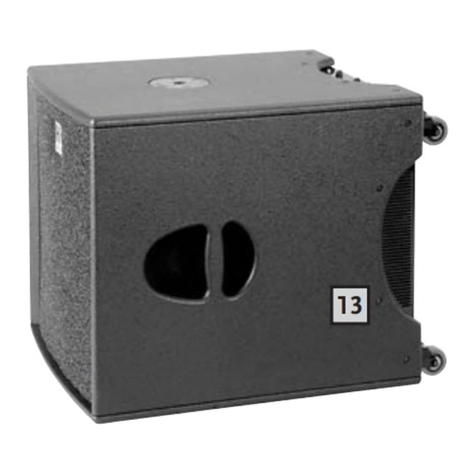
HK Audio
HK Audio L.U.C.A.S. MAX SAT Technical manual
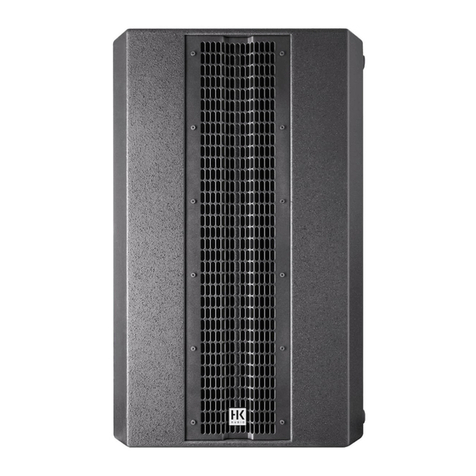
HK Audio
HK Audio L SUB 1200 A User manual
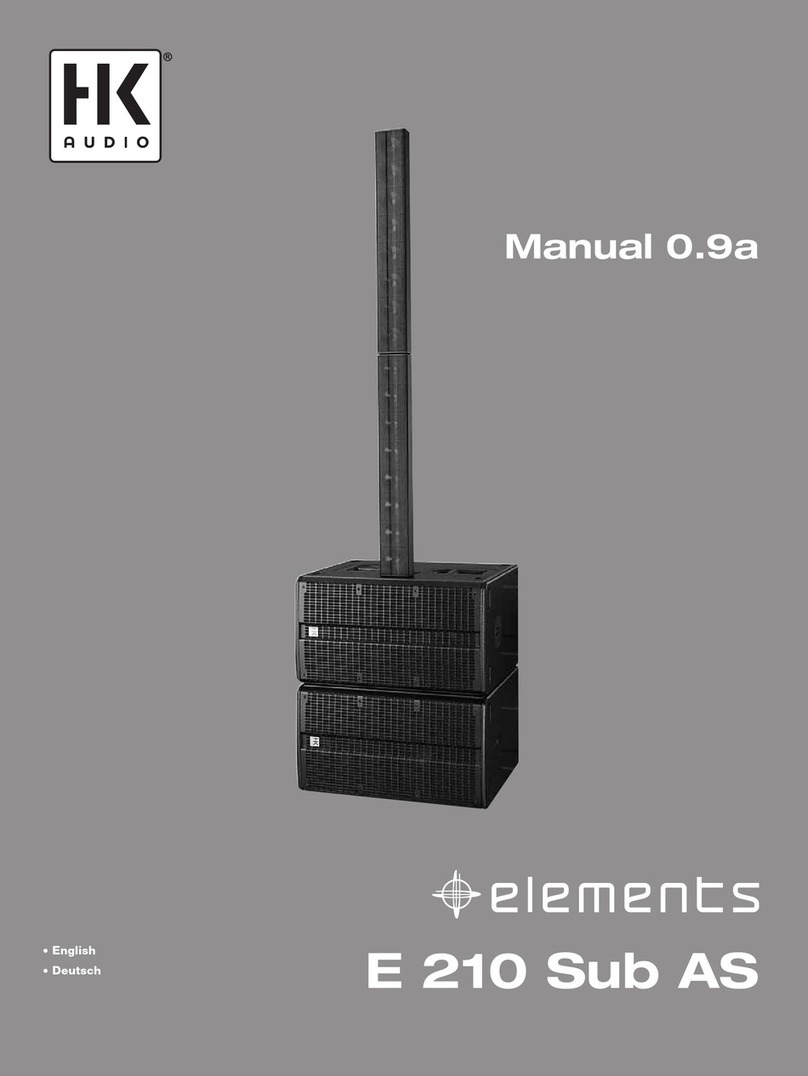
HK Audio
HK Audio E 210 Sub AS User manual
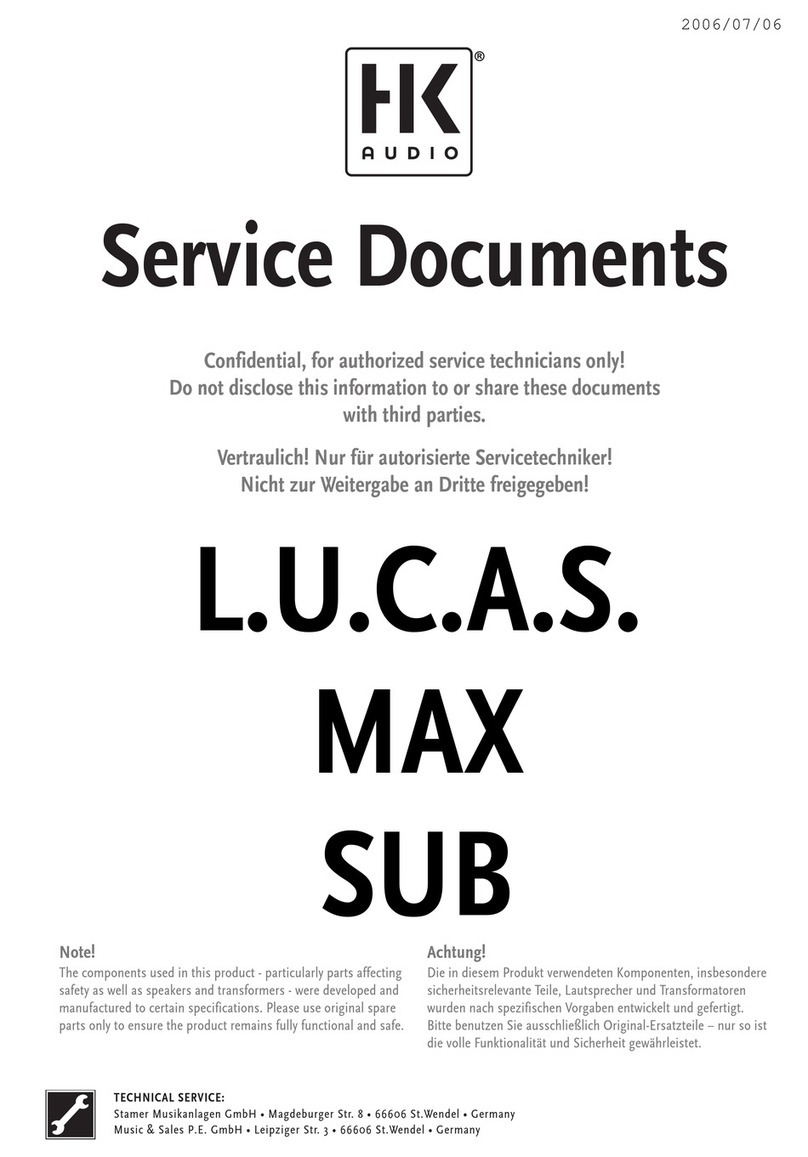
HK Audio
HK Audio L.U.C.A.S Technical manual
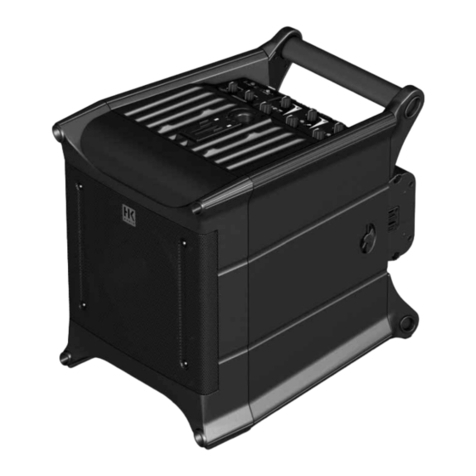
HK Audio
HK Audio Lucas nano 300 User manual
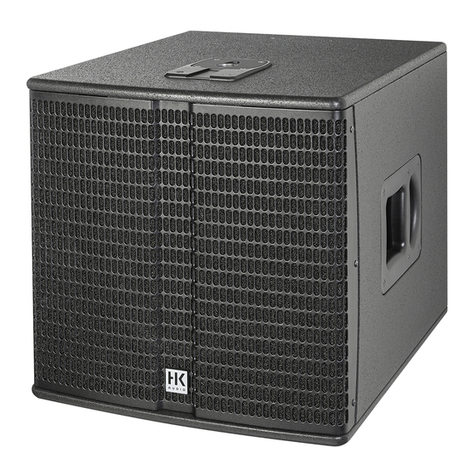
HK Audio
HK Audio ELEMENTS E 115 Sub D User manual

HK Audio
HK Audio XBA 18 User manual
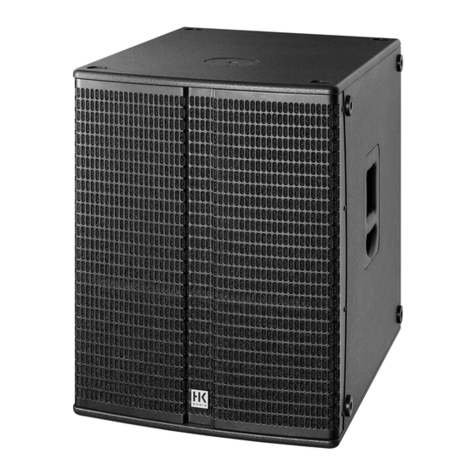
HK Audio
HK Audio L SUB 1500 A User manual
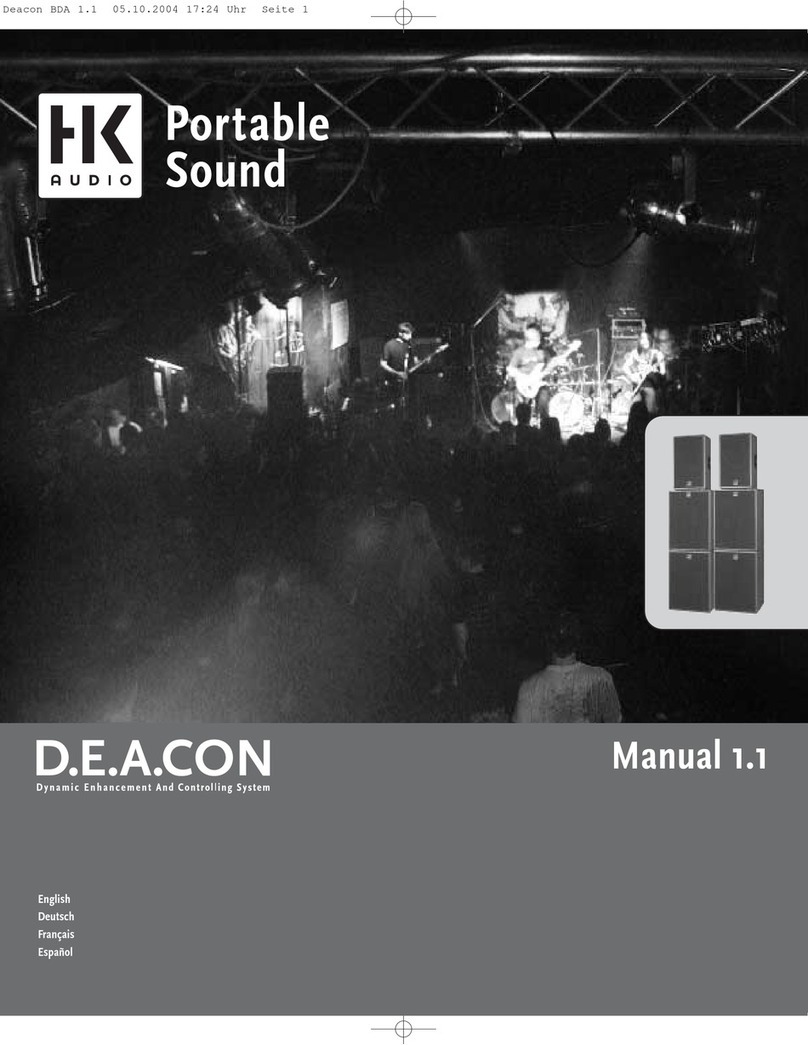
HK Audio
HK Audio D.E.A.CON User manual

